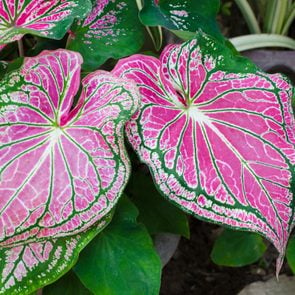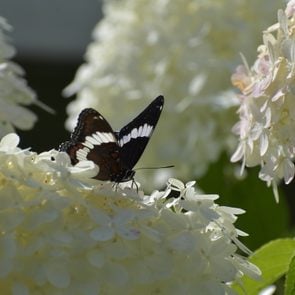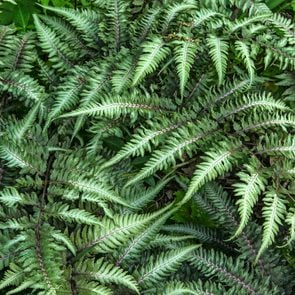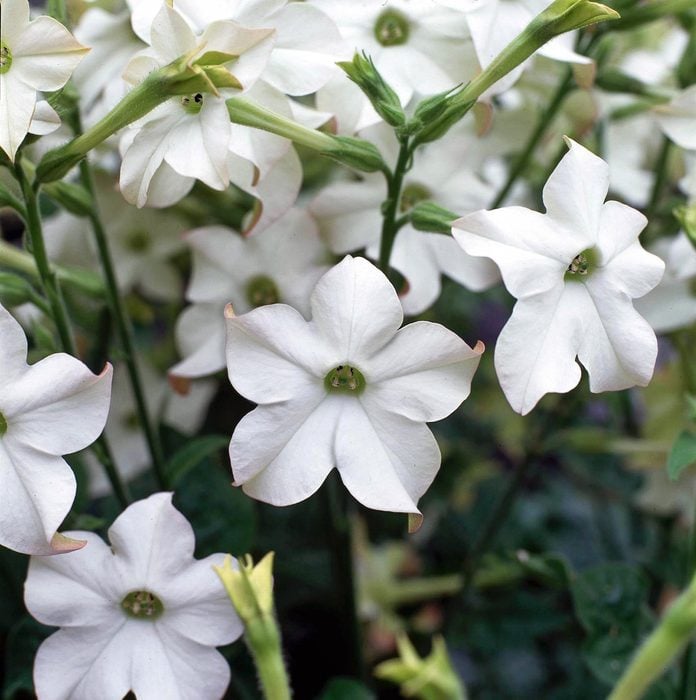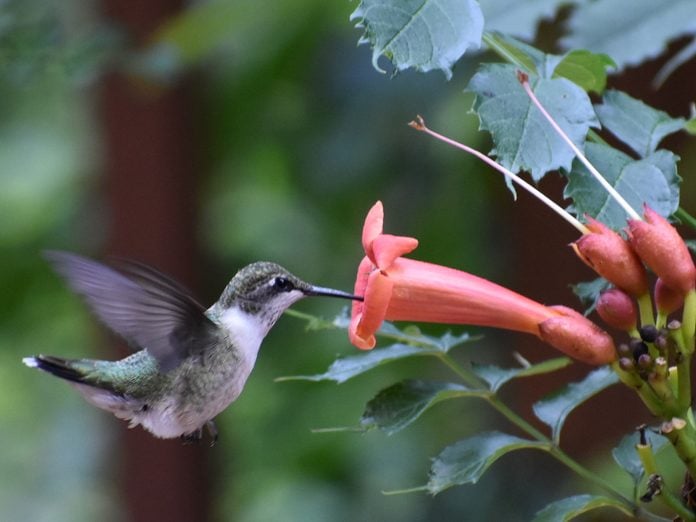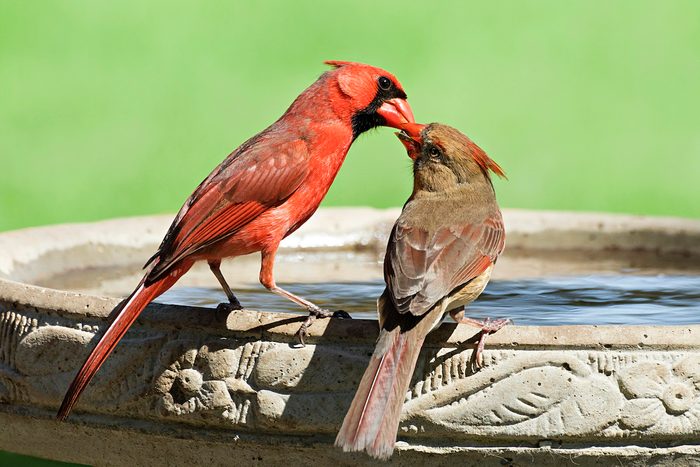
On This Page
Clean a Birdbath With Bleach
Janice Ruesch of Farport, New York, says, “I clean my birdbaths many times during the summer, but it seems like they’re not actually getting clean. What is the proper way to clean a birdbath?”
Birding experts Kenn and Kimberly Kaufman say, “Depending on the material your birdbath is made from, a mixture of water and bleach can be an effective cleaning solution. If you’re in doubt about how well the material will hold up, be sure to test a small area first before cleaning the whole bird bath.”
Did you know: Changing the water in your birdbath every few days will help keep algae from growing, making it easier to clean in the long run.
Learn how (and how often) to clean bird feeders.
How to Clean a Concrete Birdbath
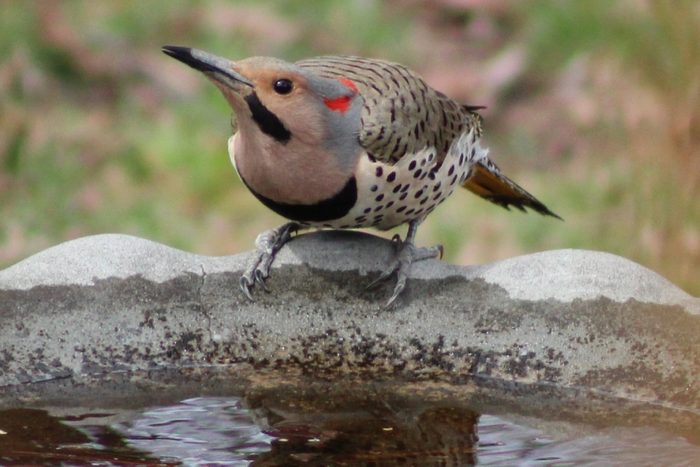
- If the birdbath is made of concrete, empty out the water.
- Using a hose with a high-pressure nozzle, spray off any built up algae or dirt.
- Add water to the birdbath until it’s almost full. Then add 1 to 1 1/2 cups of bleach.
- Cover the entire bath with a black trash bag to prevent any birds from getting to the bleach water.
- Allow it to soak for 10 to 15 minutes.
- Remove the plastic bag.
- Carefully drain the bleach water mixture in a safe area.
- Then rinse the bath for a few minutes with fresh water until you can no longer detect the smell of bleach.
Learn how to attract birds to use a bird bath.
How to Clean a Birdbath With Vinegar
You can also freshen up your backyard birdbath in a snap with vinegar. Just rinse off the surface and scrub out the basin with nine parts water to one part vinegar.
Learn how to repair a cracked birdbath.
How to Keep Algae out of a Birdbath
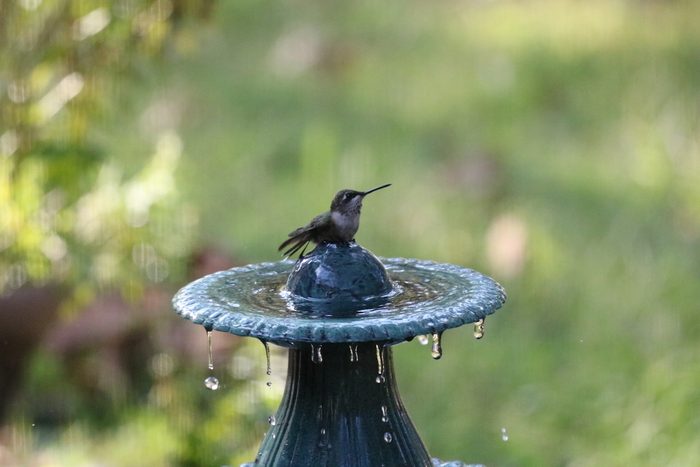
Patricia Sparks of Helendale, California, asks: “I’m careful to properly clean my birdbaths, but algae is still a problem. What should I do?”
Kenn and Kimberly Kaufman say, “Algae grow in standing water. It’s important to clean and change the water in birdbaths every few days. In hot weather, we change the water in our birdbaths every day, scrubbing with a stiff brush and rinsing thoroughly before refilling.
If algae continue to be a problem after proper cleaning, you might need to move your birdbaths to a different location. It’s best to keep them out of full sun. But avoid putting them directly under trees or shrubs where plant parts may drop directly into the water.
Moving water also helps prevent algae, so consider adding a solar fountain or dripper, which will help attract more birds too.”
“Is there a product to reduce algae growth in water fountains while also being safe for birds, tree frogs, toads and other small animals that drink from them?” asks reader Karen Zwicker of Litchfield, Illinois.
Kenn and Kimberly say, We don’t favor chemicals to control algae. Their effects on wildlife may not be fully known. Regular cleaning is a safer approach.”
Next, learn how to clean hummingbird feeders.
About the Experts
- Kenn and Kimberly Kaufman are the official birding experts for Birds & Blooms. They are the creators of the Kaufman Field Guide series and they speak and lead birding trips all over the world.
Why Trust Us?
For nearly 30 years, Birds & Blooms, a Trusted Media Brand, has been inspiring readers to have a lifelong love of birding, gardening and nature. We are the #1 bird and garden magazine in North America and a trusted online resource for over 15 million outdoor enthusiasts annually. Our library of thousands of informative articles and how-tos has been written by trusted journalists and fact-checked by bird and garden experts for accuracy. In addition to our staff of experienced gardeners and bird-watchers, we hire individuals who have years of education and hands-on experience with birding, bird feeding, gardening, butterflies, bugs and more. Learn more about Birds & Blooms, our field editor program, and our submission guidelines.
“Do birds reuse their nests? asks Birds & Blooms reader Liza Peniston of Augusta, Kansas. The short answer is that it depends on the species. Some large birds may use the same nest for years, but most, like robins, opt for new sites every time. There are endless variations in bird behavior.
On This Page
Bird That Do Not Reuse Nests
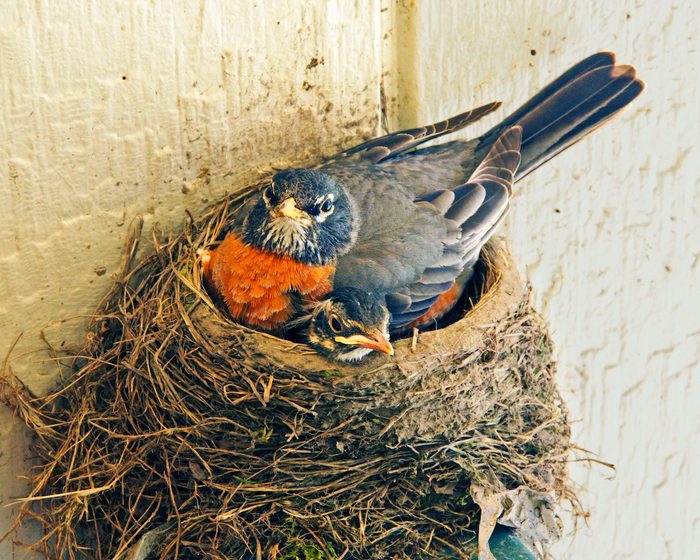
As a very general rule, smaller birds usually make their nests for a single use, especially those that build nests in the open. Most multi-brooded birds do not reuse nests because the materials are not durable enough to last through more than one brood. For instance, mourning dove nests are often flimsy and often fall apart, because the birds build them so quickly.
A lot of factors go into whether individual birds will lay eggs more than once per year. “Many species can renest if attempts fail early in the breeding season, and some regularly produce multiple broods annually,” says Sarah K. Winnicki, a Ph.D. candidate in avian evolutionary ecology at the University of Illinois Urbana-Champaign. For example, American robins may have up to three broods in one season and typically build a new nest for each brood.
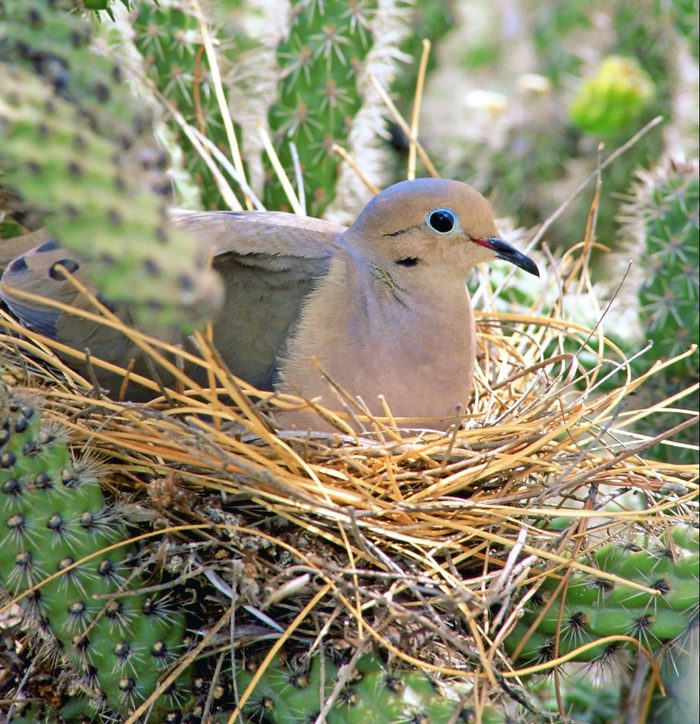
Birds most often pick a different location for later nesting sites, even after successful attempts. One grasshopper sparrow monitored by Sarah moved over 3 miles between nests. For the most part, songbirds abandon their nests after the breeding season. A few, especially cavity nesters, might return to roosting sites, but they don’t generally use the same hollows.
What types of birds mate for life?
Do Hummingbirds Reuse Their Nests?
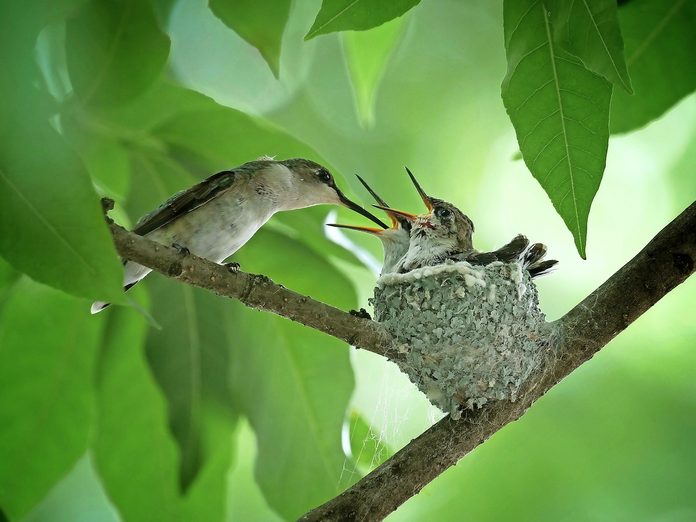
Hummingbird nests are not also durable enough for repeated use. Typically the female hummingbird will build a new nest for each brood, even within the same year. She may start construction before she finishes feeding the full-grown young from a previous one. In rare cases, a location is so good that females will build right on top of the remains of the old nest.
Psst—here’s what to do if you find a nest, eggs or baby bird.
Birds That Do Reuse Nests
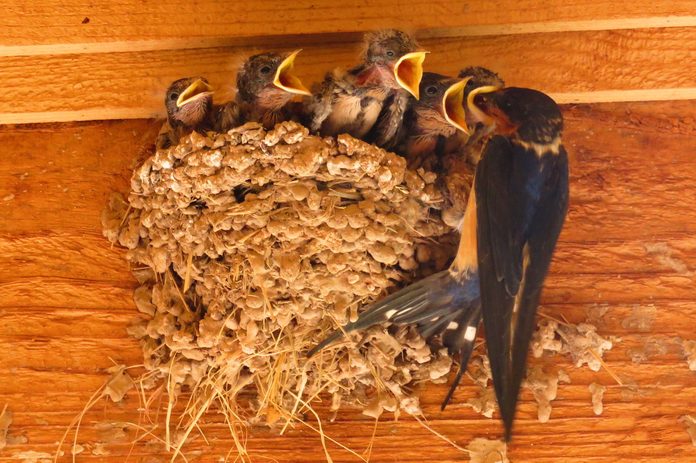
But birds that build nests in enclosed spaces, such as bluebirds or house wrens that use tree cavities or birdhouses, are somewhat more likely to use those spots for a second brood. Barn swallows may reuse an old nest, cleaning out some of the debris from the first brood and adding a new layer of mud to the rim. Other songbirds occasionally reuse a nest if it’s in good shape.
Large birds like eagles or herons may reuse the same nest, but these species only raise one brood per year.
Do Birds Live in Nests Year-Round?
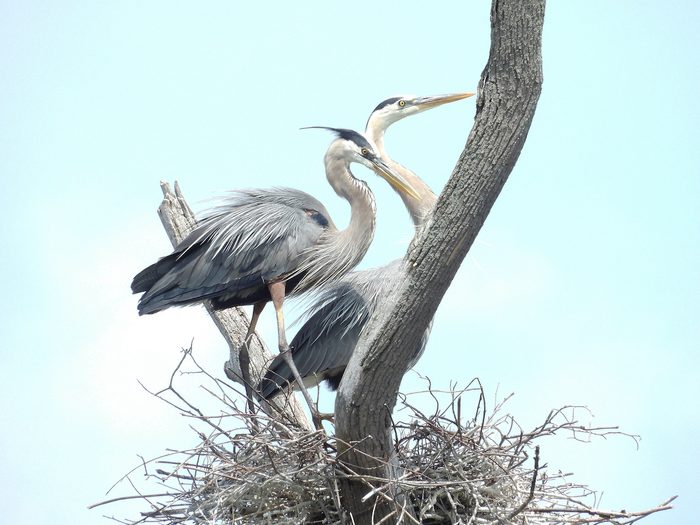
“How long do birds live in their nests?” asks reader Linda Johnson of Del Rio, Texas.
Birding experts Kenn and Kimberly Kaufman say, “In general, birds don’t live in their nests the way people live in their houses. For most birds, the nest is like a cradle: a place to incubate their eggs and feed their hatchlings until those baby birds fly away. Then the nest is usually abandoned and never used again, and the parents build a new nest for their next attempt.
Some large birds such may use the same nest year after year, and some hole-nesting birds such as woodpeckers and chickadees may sleep in those holes at night year-round. But in most cases, the nest is simply a temporary child-care structure.”
Next, learn about different types of bird nests and how to identify bird eggs by color and size.
About the Experts
- Sarah K. Winnicki is is an avian biologist and PhD candidate at the University of Illinois Urbana-Champaign. Sarah’s research focuses on growth rates of songbirds like American robins, and their past research has focused on environmental impacts on growth rates of songbirds in the grasslands.
- Kenn and Kimberly Kaufman are the official birding experts for Birds & Blooms. They are the creators of the Kaufman Field Guide series and they speak and lead birding trips all over the world.
Why Trust Us?
For nearly 30 years, Birds & Blooms, a Trusted Media Brand, has been inspiring readers to have a lifelong love of birding, gardening and nature. We are the #1 bird and garden magazine in North America and a trusted online resource for over 15 million outdoor enthusiasts annually. Our library of thousands of informative articles and how-tos has been written by trusted journalists and fact-checked by bird and garden experts for accuracy. In addition to our staff of experienced gardeners and bird-watchers, we hire individuals who have years of education and hands-on experience with birding, bird feeding, gardening, butterflies, bugs and more. Learn more about Birds & Blooms, our field editor program, and our submission guidelines.
On This Page
How to Grow Speedwell (Veronica)
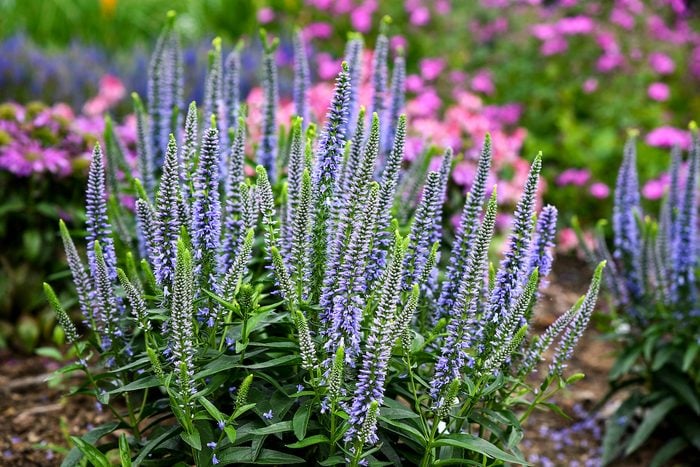
- Common name: Speedwell
- Scientific name: Veronica hybrid
- Zones: 4 to 8
- Attracts: Bees, butterflies
- Light needs: Part sun to sun, but flowers best in full sun (6+ hours a day)
- Size: 12- to 32-inches tall and form a 12- to 24-inch wide clump
- Flower color: Purple, blue, white or pink
Chris Fifo, product representative for Kieft Seed and Darwin Perennials, says, “Veronica prefers high light and full-sun garden locations. Plant it in well-draining soil that is not too heavy in clay.”
While Chris notes that speedwell will require watering until established and during dry periods, do note that these plants will not tolerate heavy, soggy soils, which may lead to root rot.
When to Plant Speedwell
Chris says these perennials are best planted in early spring, after the risk of frost has passed, and into early summer. In my Wisconsin garden, Veronica begins to bloom in mid-summer, a few weeks after native salvia varieties. Deadhead the plants for more flowers.
Is Speedwell a Native Plant?
Veronica americana (also known as American speedwell or American brooklime) is native to North America.
Do Deer Eat Speedwell Flowers?
Speedwell plants are not often bothered by deer and rabbits. “Veronica are a good choice for deer resistance, but not fully deer-proof. Honestly, deer will take a bite of everything if given the chance,” Chris says.
Do Speedwell Plants Spread?
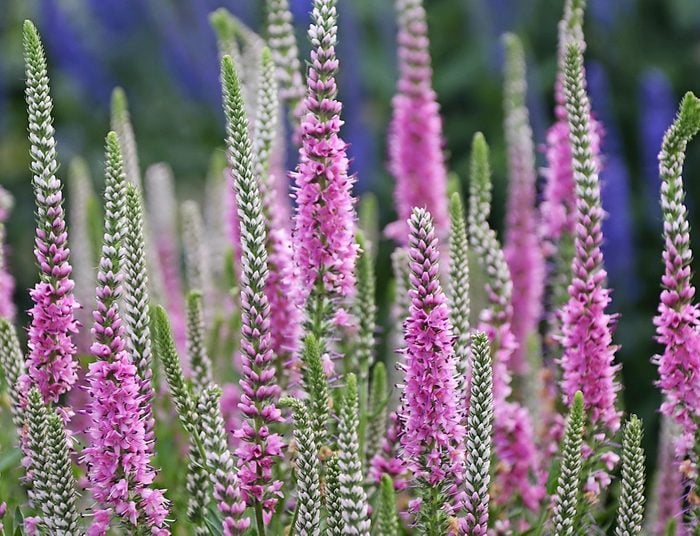
These perennials are well behaved in the garden, meaning they stay put where you plant them and don’t reseed or become weedy.
“Most Veronica species form a clump but do not truly spread,” Chris says. Clumps can be divided when they get large enough.
Speedwell Plant Problems
Chris says some Veronica plants are susceptible to powdery mildew. Look for varieties that offer powdery mildew resistance.
Preventative sprays of organic lightweight horticultural oil and synthetic fungicides can also be beneficial. As always, read and follow label directions, whether using organic or synthetic chemicals.
Cultivars to Try
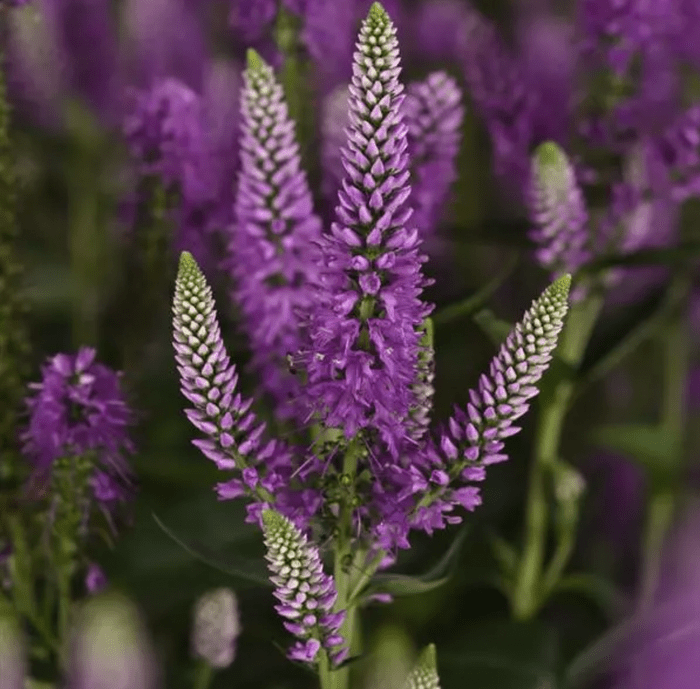
Magic Show Ever After is of the longest-blooming speedwells available, Ever After features almost 1-foot tall purple flower spikes that extend the growing season from early to midsummer. The flowers are self-cleaning so they will always look fresh for the pollinators that love it.
This speedwell will perform in many places in the garden, including a border or mass planting. But it also serves as the thriller in a potted combination.
Other Magic Show speedwells include White Wands and Wizard of Ahhs, which has even bluer blooms than Ever After.
Veronica Skyward is a new series offered by Darwin Perennials. Chris says Skyward has strong stems that do not fall open, and this series is also selected for superior mildew resistance.
For bubblegum pink flowers that attract bees, try Perfectly Picasso.
Sources
- Proven Winners
- Darwin Perennials
- Walters Gardens, Inc.
About the Expert
Chris Fifo works as a product representative for Kieft Seed and Darwin Perennials. He earned a degree in horticultural science from Iowa State University.
Why Trust Us?
For nearly 30 years, Birds & Blooms, a Trusted Media Brand, has been inspiring readers to have a lifelong love of birding, gardening and nature. We are the #1 bird and garden magazine in North America and a trusted online resource for over 15 million outdoor enthusiasts annually. Our library of thousands of informative articles and how-tos has been written by trusted journalists and fact-checked by bird and garden experts for accuracy. In addition to our staff of experienced gardeners and bird-watchers, we hire individuals who have years of education and hands-on experience with birding, bird feeding, gardening, butterflies, bugs and more. Learn more about Birds & Blooms, our field editor program, and our submission guidelines.
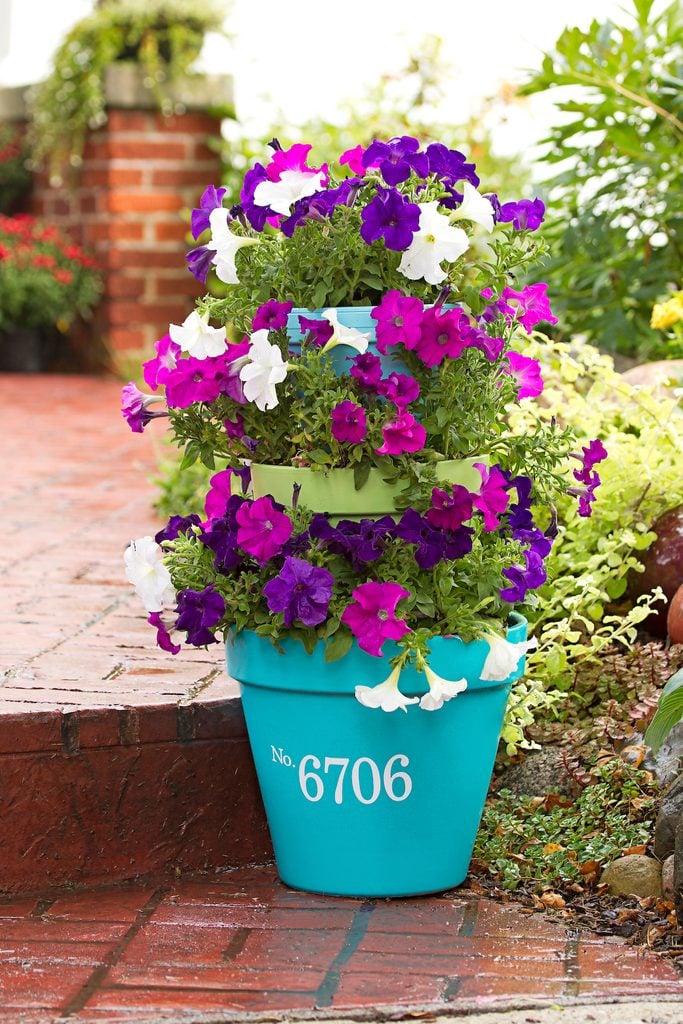
Recycle old clay pots into new front-porch decor. It’s a perfect way to put your house number, family name or the word “Welcome” on display for all to see. You can buy precut outdoor vinyl numbers or letters online or at the hardware store. Gather up the supplies below to get started crafting a stacked flower pots project for your home!
Here’s how to make a mini fairy garden in a birdbath planter.
Stacked Flower Pots Materials:
- 5 round terra-cotta pots (8 in., 10 in., 12 in. and two 6 in.)
- Spray paint in your choice of 3 colors
- 4-in.-tall x 2-in.-wide (or slightly larger) outdoor vinyl house numbers or letters
- Potting soil and flowers
- Waterproof epoxy or outdoor glue (optional)
Step-By-Step Instructions:
Step 1
In a well-ventilated area, spray-paint the exterior of the 8-in., 10-in. and 12-in. pots in your choice of colors. Apply as many coats as needed, drying completely between coats, for full coverage. Let pots dry 24 to 48 hours.
Step 2
Following manufacturer’s instructions, apply vinyl numbers or letters centered on one side of the 12-in. painted pot.
Step 3
Put about 2 in. of potting soil in the 12-in. pot. Then place an unpainted 6-in. pot upside down, centered on the potting soil. Press the upside-down pot’s rim into the soil to secure in place. Do the same, using more soil, inside the 10-in. pot with the remaining 6-in. pot. (The bottoms of these upside-down pots will provide a platform for the painted pots to sit on, forming tiers.)
Step 4
Stack the 10-in. pot inside the 12-in. pot, using the upside-down pot as a base. Do the same for the 8-in. pot inside the 10-in. pot. If desired, use a waterproof epoxy or outdoor glue to stabilize the pots.
Step 5
Fill all three stacked pots with potting soil, stopping a few inches from the rims. (The soil should completely cover the upside-down pots, if possible.) Then plant flowers as desired and display your creation on your front porch. Don’t forget to water it!
Stacked Flower Pot Plant Picks
We used petunias for the stacked flower pots pictured above. They’re a good choice for a project like this because they’re easy to maintain, bloom throughout the summer and come in a variety of colors. Petunias prefer full sun, so if you’ve got a covered porch, try shade-tolerant coleus or begonias.
On This Page
What Does a Little Blue Heron Look Like?
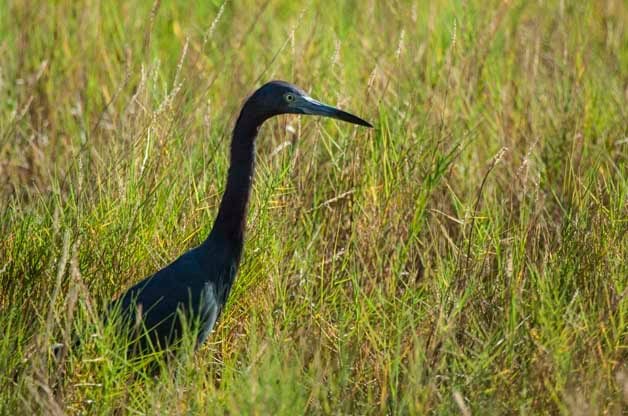
Little blue herons are about half the height and have half the wingspan of great blue herons. Like most wading birds, these herons are typically spotted near water, looking for prey. It’s their dark color that really sets them apart.
Erika Zambello, communications director for Audubon Florida, says, “Adult little blue herons are very distinctive. Their feathers are dark blue and purple, giving them a very dark silhouette as they forage in wetlands.
Despite their name, Erika says these birds are more closely related to snowy egrets than great blue herons.
Discover more types of egrets and herons found in North America.
Juvenile Little Blue Heron
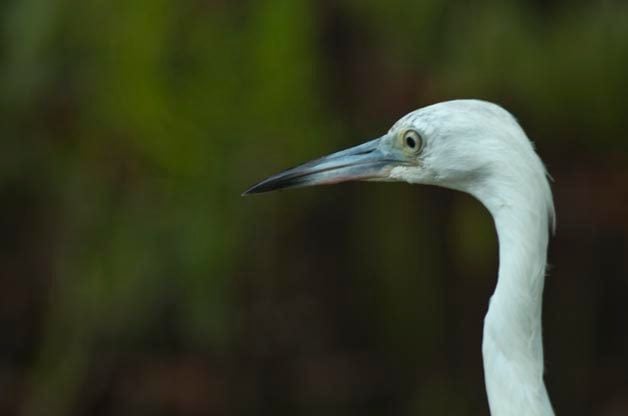
Although adult little blue herons are dark blue, the young birds are all white. This makes them look more like snowy or cattle egrets.
“Their bills, however, are blue with a dark tip, which is similar to their bills as adults,” Erika says.
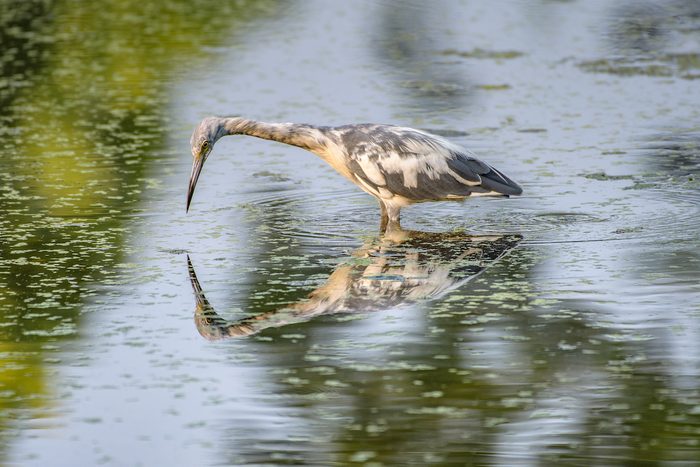
As the young little blue herons begin to molt into their adult plumage in the spring, they get a pied or patchy look with both white and dark blue feathers.
Little Blue Heron Range
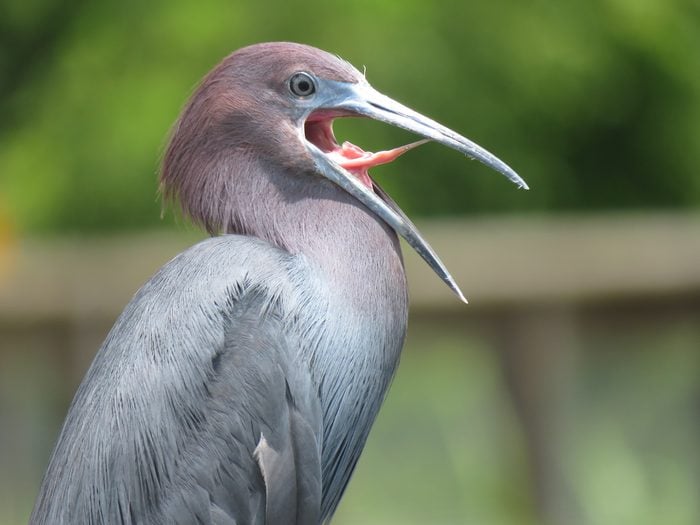
In North America, the little blue heron can be found year-round in Florida and the Southeastern U.S.
During summer, their range extends inland. Rob Ripma, owner of Sabrewing Nature Tours, says, “Although they don’t breed in the Midwest where I live, they can be found here in the late summer. It’s almost always birds that were hatched earlier in the summer that arrive.”
Rob notes that this post-breeding dispersal into the Midwest doesn’t happen every year, but you can track recent sightings on eBird.
Little Blue Heron Habitat
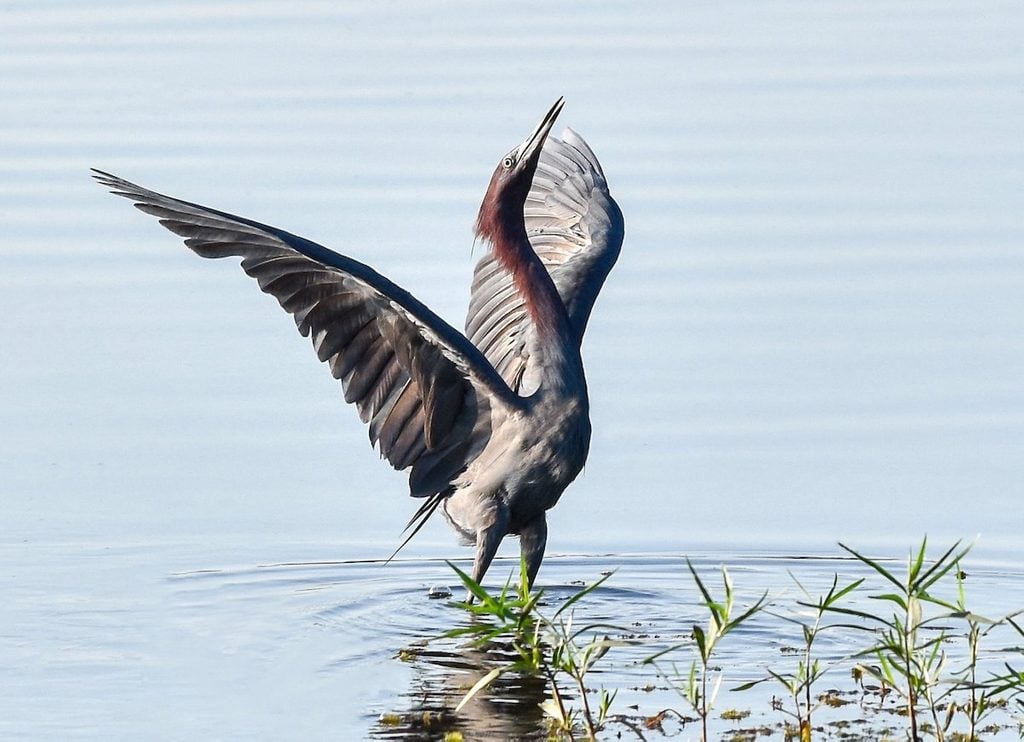
“They will use any kind of wetland, where they patrol the shallow edges for food,” Erika says. This includes lakes, ponds, ditches, wet fields, rivers, and more. “They depend on wetlands to survive and thrive, and it puts their populations at risk when wetlands are drained and developed.”
Some studies have found that their numbers have fallen by almost 50 percent since the 1960s as the birds have lost habitat.
Rob says, “The little blue heron’s population is unfortunately making a slow decline. Even though breeding sites are protected, the wetlands that they feed in are disappearing.”
Head to the shore to see beach birds.
What Do Little Blue Herons Eat?
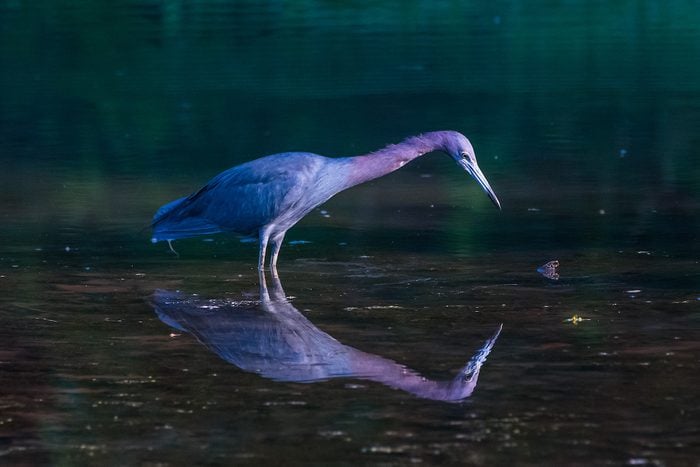
These birds mostly eat small fish, but Erica says they are also known to eat amphibians, large insects and crustaceans.
Nesting Habits
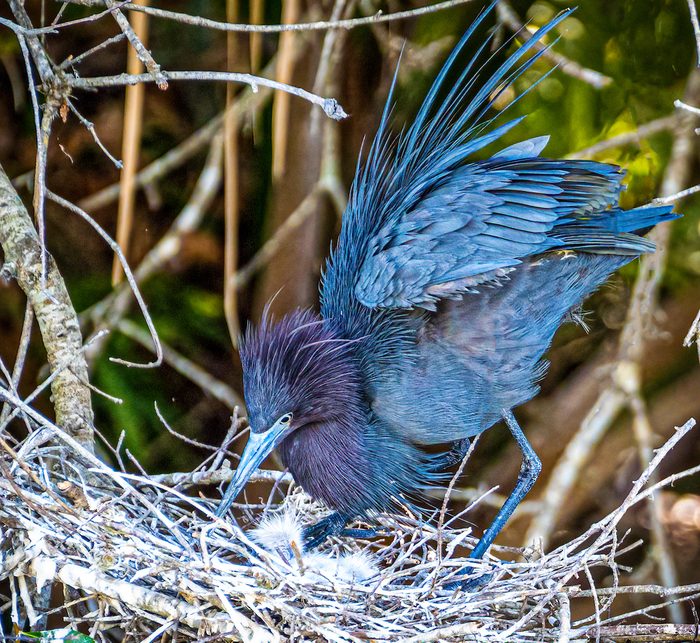
Erika says, “Little blue herons nest in colonies with other wading birds, like herons, egrets, and ibis. They use sticks and twigs to build their nests.”
The female lays three to four blueish eggs. Both parents bring food back for the young.
Learn more about great egret nests.
Sound and Calls
Bird sounds courtesy of the Cornell Lab of Ornithology
According to Erika, the birds are mostly silent, and when they do make noise, it’s a guttural croak.
About the Experts
- Erika Zambello is the communications director for Audubon Florida. A former National Geographic Young Explorer, she has a master’s degree in environmental management, ecosystem science and conservation from Duke University.
- Rob Ripma is co-owner of Sabrewing Nature Tours. He is the past president of the Board of the Amos Butler Audubon Society in Indianapolis and secretary for Ohio’s Black Swamp Bird Observatory. Rob is also a co-founder of the Indiana Young Birders Club.
Sources
- Audubon Florida
- Cornell Lab of Ornithology
- National Audubon Society – little blue heron
Why Trust Us?
For nearly 30 years, Birds & Blooms, a Trusted Media Brand, has been inspiring readers to have a lifelong love of birding, gardening and nature. We are the #1 bird and garden magazine in North America and a trusted online resource for over 15 million outdoor enthusiasts annually. Our library of thousands of informative articles and how-tos has been written by trusted journalists and fact-checked by bird and garden experts for accuracy. In addition to our staff of experienced gardeners and bird-watchers, we hire individuals who have years of education and hands-on experience with birding, bird feeding, gardening, butterflies, bugs and more. Learn more about Birds & Blooms, our field editor program, and our submission guidelines.
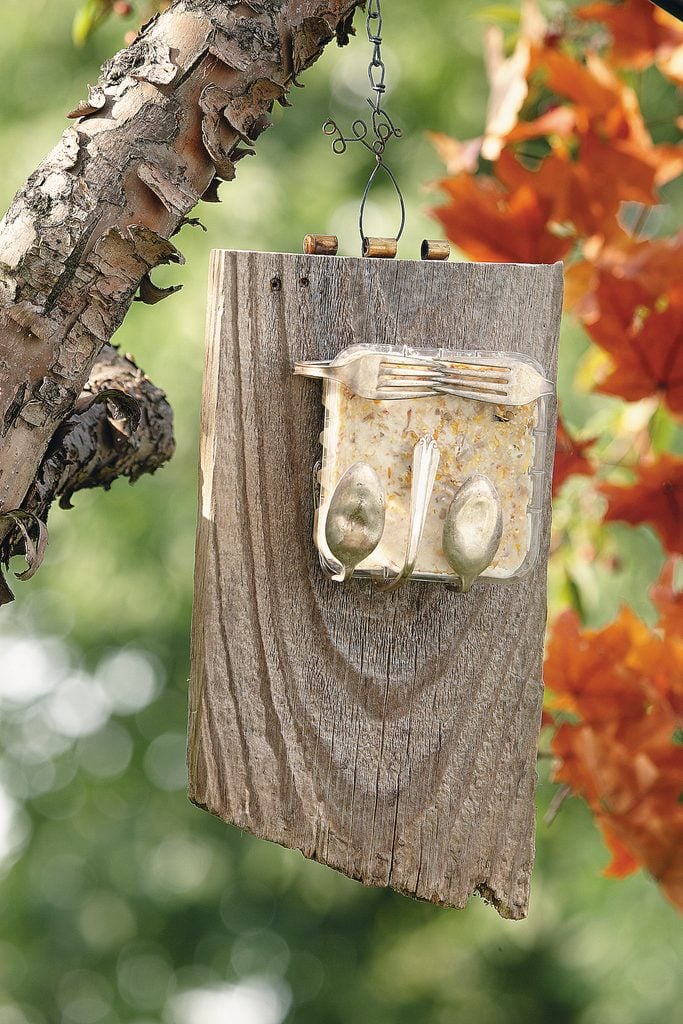
Your backyard birds deserve a fine dining experience, so serve up their suet in this elegant yet functional homemade bird feeder. Old silverware holds the suet in place for a whimsical way to feed your birds. It takes only a little while to assemble this homemade suet feeder, and you can be sure no one else on the block will have one just like it! Before you know it, your birds will be lining up for a seat the your table.
Check out common questions about feeding suet to birds.
Materials:
- Weathered board, 2 ft. long and at least 9 in. wide
- Silver-plated flatware, five pieces
- Hinge
- Wire, 18 in. long, 20-gauge
- Screws, assorted sizes to fit hinge holes and drilled silverware
- Drill bits
- Scrap piece of two-by-four
- Drill press or hand drill
- Nail
- Rubber mallet
- Screwdriver
- Wire cutter
- Pliers
- Safety goggles
- Gloves
- Wrapped suet cake (Note: If you’d like to use homemade suet in your silverware feeder, simply put it in a plastic tray so it doesn’t fall apart.)
Step-By-Step Instructions:
Step 1
Pound silverware as flat as you can with a rubber mallet. The more rustic it looks, the better!
Step 2
Use the nail to make divots in handles of the silverware to keep the drill bit from skipping. With safety goggles on, drill holes with drill press or hand drill, keeping drill bit perpendicular to silverware.
Step 3
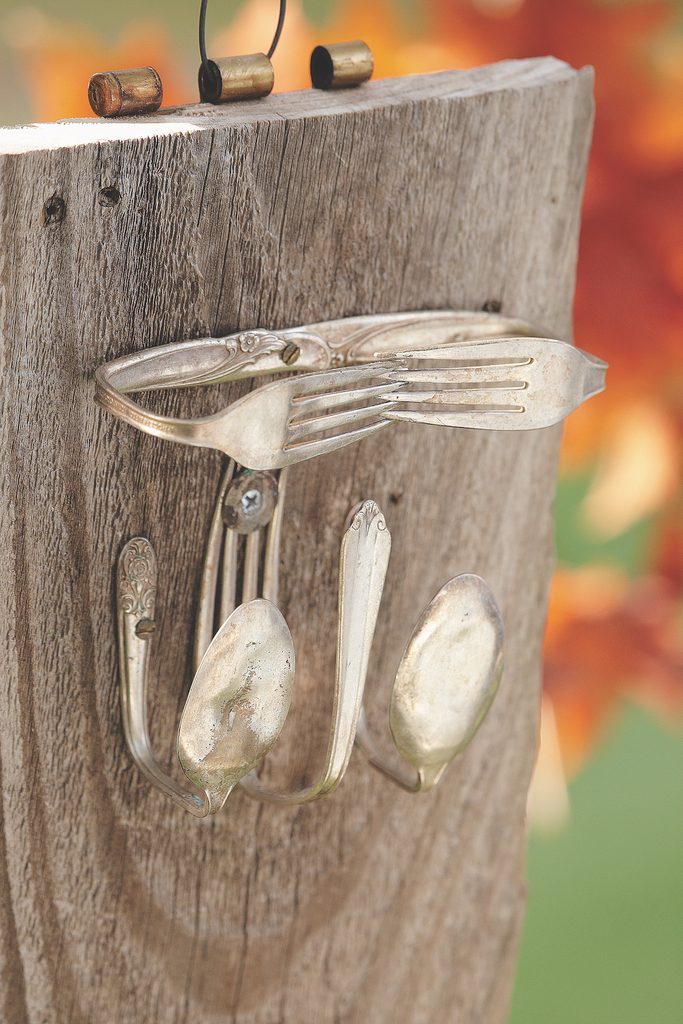
To make the first bend, place one piece of silverware, decorative side up, on a sturdy surface. Place two-by-four on top of the handle, and bend the silverware up at a 90-degree angle. Wear gloves if you like, and repeat with remaining silverware.
To determine where silverware should go, place a wrapped suet cake on the weathered board; mark with a pencil. Place silverware on the board to hold suet, and attach with screws.
Step 4
Make the second bend by placing the two-by-four flush with each piece of silverware and bending the silverware over the two-by-four. Refer to photo, and use the rubber mallet to help, if necessary.
Step 5
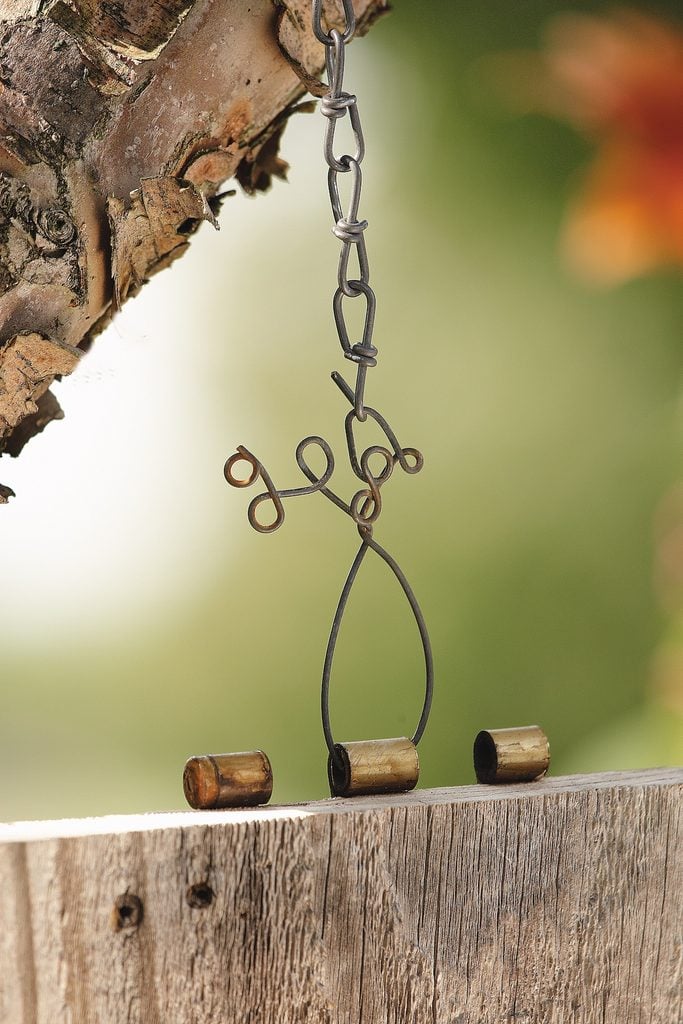
Attach a hinge to the back of the board. The tubular part of the hinge should be just above the edge. String wire through the center of the hinge and curl it with pliers to make decorative loops for hanging.
Remove the wrapper from a store-bought suet cake, but leave it in the plastic tray. Insert into the feeder.
Next, learn how to clean a suet cage bird feeder.
Shade—you either love it or hate it. Gardeners often fall into the latter category because low-light conditions prevent the development of lush lawns, leaving shady areas looking bare, or worse yet, weedy. That doesn’t mean you should write off shady sections of your yard as no-grow zones, however. There are plenty of shade ground cover plants that can be used in place of standard grass. These perennial ground covers will naturally spread over time to create a lush carpet under trees, between buildings or in other places that don’t see much sunlight.
On This Page
Best Shade Ground Cover Plants
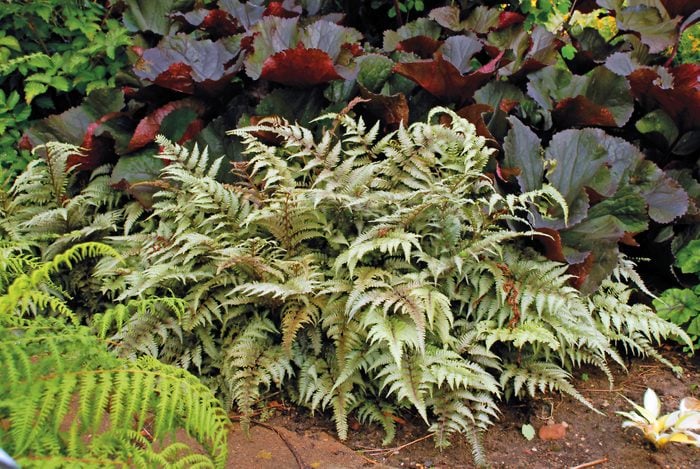
Here’s a quick list of shade ground covers that will add pizzazz to your landscape. To make sure these plants aren’t considered invasive in your area, check with your local county Extension service. And while you’re at it, ask what they recommend for shade ground covers that perform well in your area.
Consider what shade ground cover plant is most suitable for your climate and soil. If you live in the Southwest, where the weather is hot and dry for long periods, bearberry and lady’s mantle are good choices because they don’t require much water, and they thrive in heat.
Pachysandra and lamium can handle colder Midwestern and New England winters and are easy to control. Traditional lily-of-the-valley and periwinkle also thrive well in these regions, but they need to be contained or they can quickly spread and become invasive.
Florida violets and Japanese painted fern prefer lots of shade, moisture and heat, making them ideal for humid climates. There are plenty more to choose from. Many of these ground covers do more than green things up in the shade—they also produce flowers that will add delightful dashes of color where you least expect them.
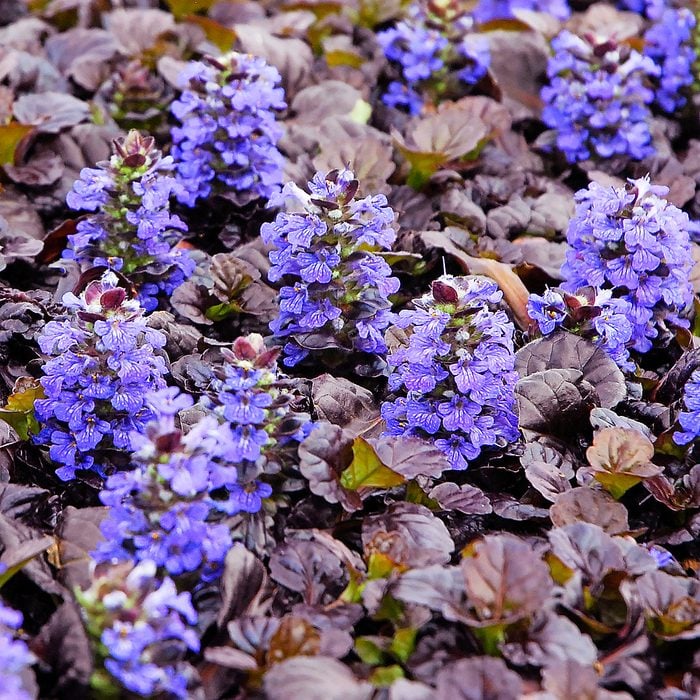
Bugleweed
Ajuga, Zones 3 to 9
This beauty features masses of green, bronze or variegated foliage. Spires of blue flowers appear in late spring to early summer. Bugleweed may invade lawns, making it more suitable for areas surrounded by stones or other barriers.
Bearberry
Arctostaphylos, Zones 2 to 8
Rocky and sandy soils are perfect for this hardy, low-growing evergreen, making it good for drought-tolerant gardens. The plant also produces white or pink flowers in spring and red berries in fall.
Ginger
Asarum, Zones 4 to 9
Both evergreen and deciduous varieties are available. It will tolerate extremely low-light conditions and do well in the dense shade at the base of an evergreen.
Japanese Painted Fern
Athyrium niponicum, Zones 3 to 8
This low-maintenance plant was named Perennial Plant of the Year in 2004. It flourishes in moist, humid areas, and the texture and color of its fronds make it a great ground cover for any shade garden.
Lady’s mantle
Alchemilla, Zones 3 to 8
Soft-green leaves form a nice mat and spread steadily. Chartreuse flowers appear in late summer or fall.
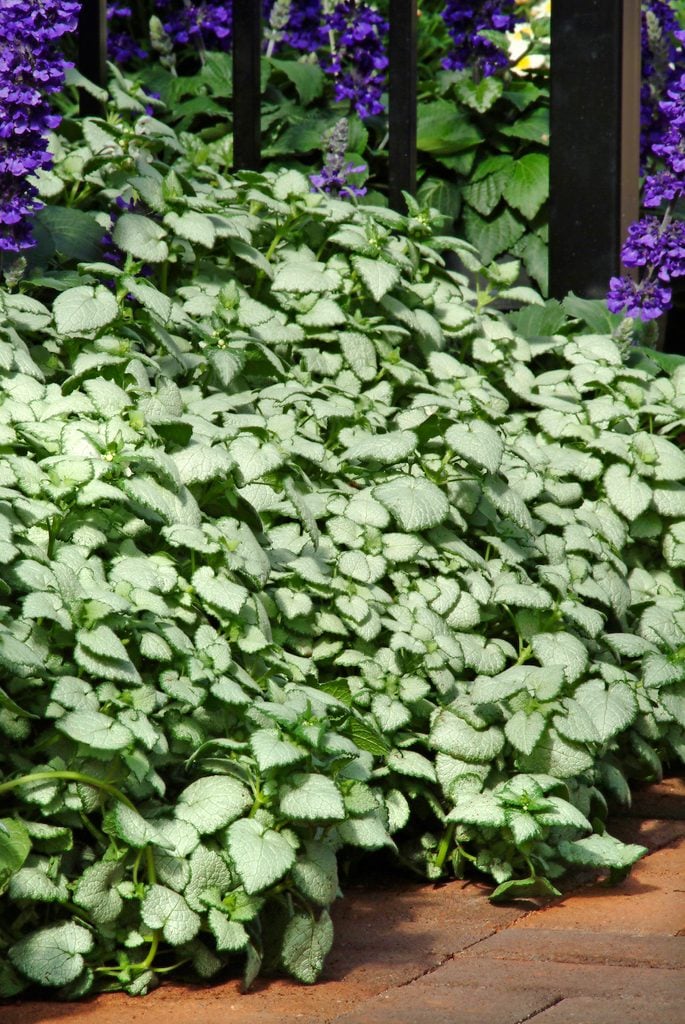
Lamium
Lamium maculatum, Zones 4 to 8
Good in dry shade, the variegated leaves add a bright note from spring to fall. Pretty white or mauve flowers show up in May or June.
Pachysandra
Pachysandra terminalis, Zones 4 to 8
This well-known shade lover offers glossy evergreen foliage with white flowers in spring. Zones 4 to 8.
Partridgeberry
Mitchella repens, Zones 4 to 8
This evergreen features fragrant white flowers and red berries, prefers acidic soil and can handle moist to dry conditions.
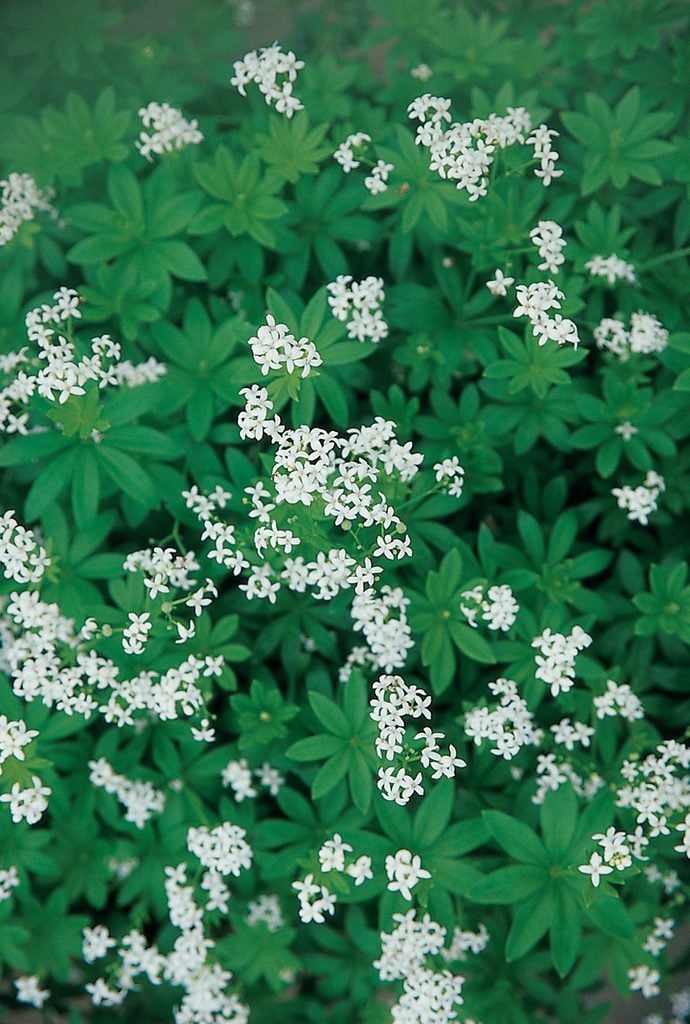
Sweet Woodruff
Galium odoratum, Zones 4 to 8
Despite its delicate appearance, this plant is tough and well suited to wooded areas. Its white spring blooms last for several weeks, and even its leaves have a pleasant scent.
Winter Creeper
Euonymus fortunei, Zones 4 to 9
Trailing types of this mounding evergreen make great ground covers for shade. Winter creeper spreads easily, forming roots wherever its stems touch the ground.
Full Shade or Partial Shade?
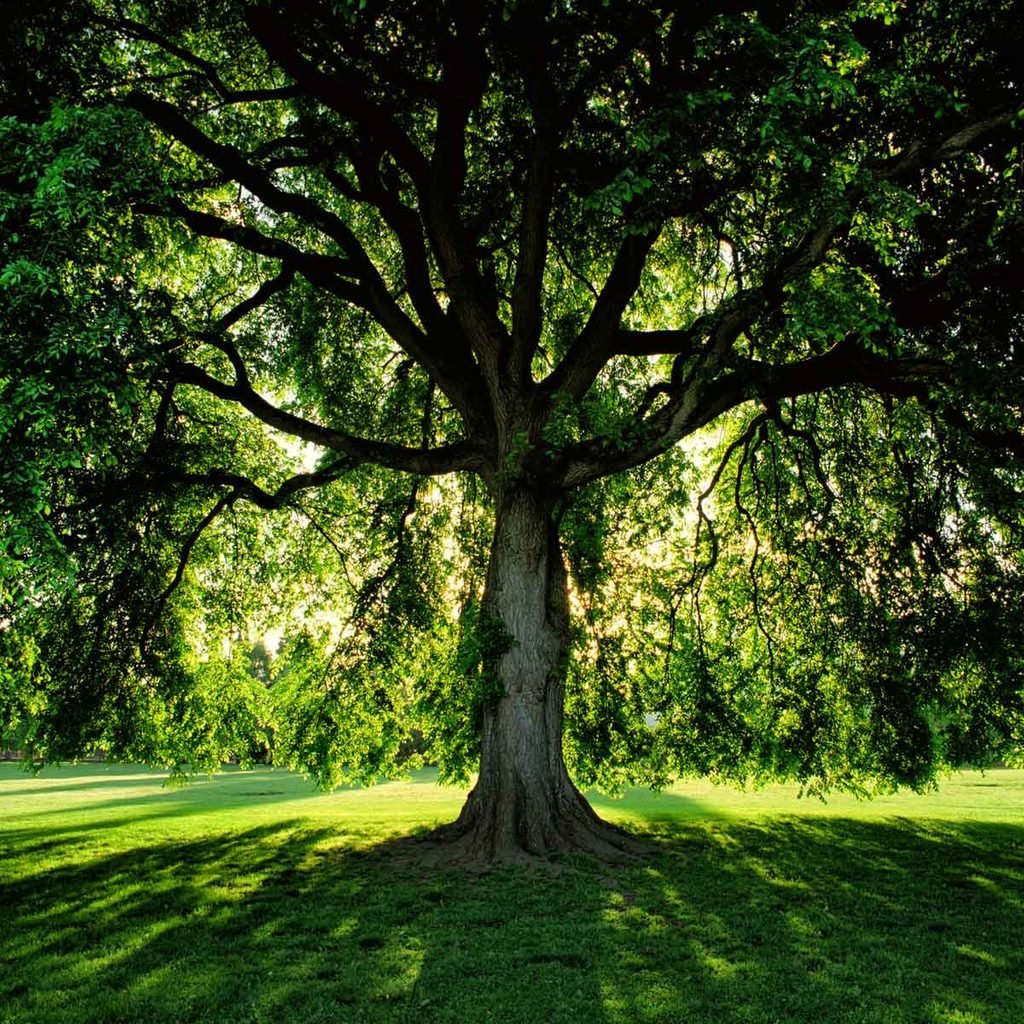
Before you grab any garden tools, it’s important to consider exactly what kind of shade you have. Survey the area at various times of day to gauge how much light it receives…and keep in mind that the amount of shade can vary from one season to the next due to the changing position of the sun and the density of the tree canopy.
So, what did you see? If sunlight is only partially blocked by open structures or trees with small leaves, like birch or honey locust, chances are good the shade is dappled or filtered. This means that plants will receive a mixture of bright light and shade throughout the day, a situation that is suitable for many flowers and ground covers.
Or perhaps the area gets 4 to 6 hours of light per day, and the rest of the time it’s in shade. This is considered partial shade and often occurs on the east or west sides of a house, or on the edge of a stand of trees. A wide variety of plants will grow in these conditions.
Spots that receive no direct sunlight, such as ground directly underneath Norway maples, oaks, spruces, pines and other trees with dense canopies, are in full shade, and only plants that tolerate low-light conditions will thrive there.
Prepare the Shade Garden for Planting
Once you’ve determined what kind of light conditions you have, you’re ready for the next step—preparing the site prior to planting.
“Even at this point, I caution gardeners to go slow, especially if they’re trying to fill in bare spots under trees where grass won’t thrive,” says Birds & Blooms garden expert Melinda Myers.
“The feeder roots for most trees are in the top 12 inches of soil directly under the tree, and if you dig too deeply when removing grass or installing ground covers, you can damage these roots. The goal here is to create an attractive cover for a barren area, but not at the expense of the trees.”
Remove Grass
Melinda suggests removing the grass beneath trees in one of two ways. Cover the shady area with several layers of newspaper, grass clippings, wood chips or other organic mulch to eliminate what is growing there, or use an all-vegetation-killing chemical.
The second method produces immediate results, but be sure to read and follow all label directions carefully to avoid damaging nearby plants (including your trees). It will also tell you how long to wait before planting again, which is generally 4 to 14 days. The first method of grass removal is preferable because it is chemical free, though it does require patience. It typically takes about a year to complete, but it enriches the soil and won’t harm future plantings.
Shade Ground Cover Care
Planting is pretty simple. The only thing to keep in mind is to avoid disturbing tree roots, which you can do by digging slightly wider and shallow holes rather than tilling up the entire planting area. After gently tamping the plants in place, apply a generous layer of mulch and water thoroughly—then keep an eye on things.
“Although much of the work is now done, the first few years are critical,” Melinda says. “Your ground cover will thrive if you put in a little extra effort in the beginning. People often don’t realize that areas under trees, particularly those with heavy canopies, are actually dry and require regular watering. Those thick layers of leaves shed rain pretty well. Even a lengthy downpour might not penetrate the soil enough to make a difference.”
And just like any newly planted garden, it’s important to stay on top of weeding. Removing unwelcome plants reduces competition for water and nutrients and gives the ground covers the opportunity to become established.
But it won’t be long before that once-barren area under the maple or next to the house is lush and green. And that’s when you know you’ve got it made in the shade!
About the Expert
Melinda Myers is the official gardening expert for Birds & Blooms. She is a TV/radio host, author and columnist who has written more than 20 gardening books. Melinda earned a master’s degree in horticulture from the University of Wisconsin-Madison.
Why Trust Us
For nearly 30 years, Birds & Blooms, a Trusted Media Brand, has been inspiring readers to have a lifelong love of birding, gardening and nature. We are the #1 bird and garden magazine in North America and a trusted online resource for over 15 million outdoor enthusiasts annually. Our library of thousands of informative articles and how-tos has been written by trusted journalists and fact-checked by bird and garden experts for accuracy. In addition to our staff of experienced gardeners and bird-watchers, we hire individuals who have years of education and hands-on experience with birding, bird feeding, gardening, butterflies, bugs and more. Learn more about Birds & Blooms, our field editor program, and our submission guidelines.
Hummingbird flowers have three things in common. Their blooms are tube-shaped, brightly colored, and they grow where it’s easy for hummingbirds to hover and sip. If you want to attract more of these beautiful birds, plant these flowers that hummingbirds like in your yard or garden.
Want more birding and gardening tips? Subscribe to our free daily newsletter.
On This Page
Cardinal Flower
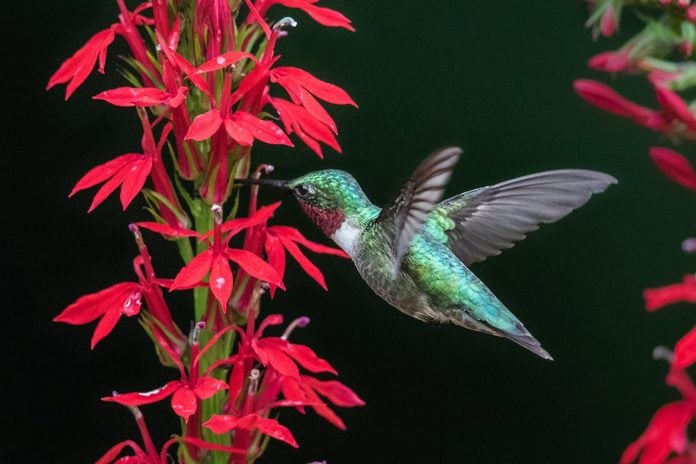
Lobelia cardinalis, Zones 2 to 9
Size: 3 to 4 feet tall, 1 to 2 feet wide
Cardinal flower, named for the red robes worn by Roman Catholic cardinals, needs mulch to retain moisture during summer and protect its root system during cold northern winters. It’s one of the top hummingbirds flowers you should grow.
Why we love it: This deer-resistant, reseeding and self-rooting perennial lights up partial shade or full sun areas that boast consistently moist soil. Flower spikes open from bottom to top, and stay in bloom for several weeks.
Check out the top 10 red hummingbird flowers.
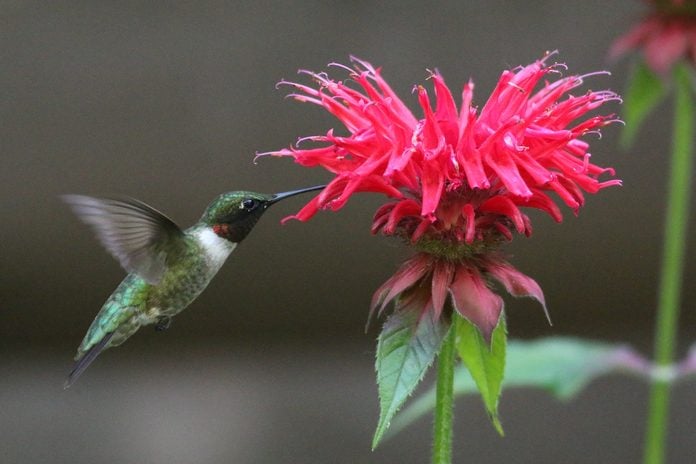
Bee Balm
Monarda species, Zones 4 to 9
Size: 1 to 4 feet tall and wide
For a surefire way to attract hummingbirds with flowers, grow bee balm. This beauty grows up to 4 feet tall in full sun and starts flowering in midsummer. You can even find several varieties on the market that are resistant to mildew. Whether you choose natives or cultivated varieties, the birds can’t resist the nectar-rich blooms. Bee balm needs sun, moist soil, and plenty of air circulation to ward off powdery mildew.
Why we love it: After the tubular pink, red, white or violet flowers fade, the round seed heads add beauty in fall and winter and may self-sow.
“I grow bee balm in the middle of my flower beds and am always rewarded with the company of hummingbirds while tending my gardens,” says Miriam Guyor of St. Clair, Michigan.
Check out the top annual flowers that attract hummingbirds. Then, take a look at the best perennials to grow for hummingbirds.
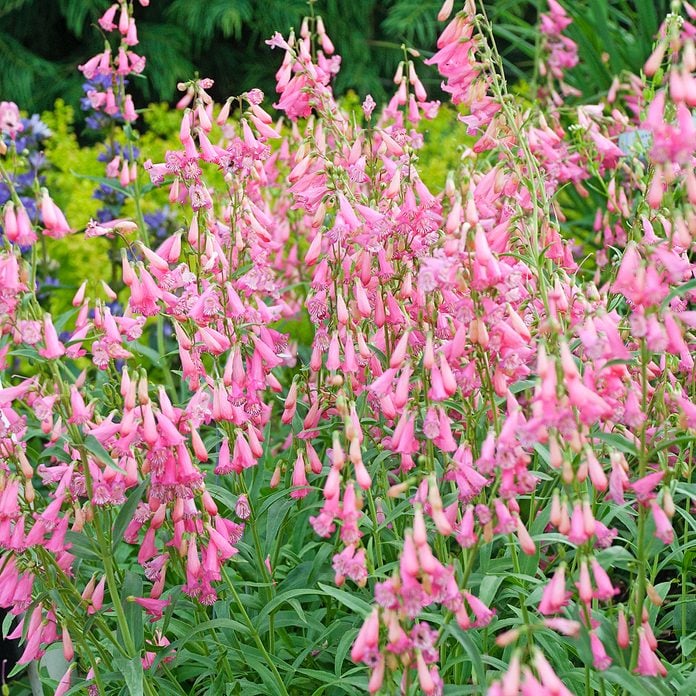
Penstemon
Penstemon species, Zones 3 to 9
Size: 1 to 4 feet tall
Penstemons are North American natives that come in many forms. It’s best to plant those that are native to your area. These hummingbird flowers are low-maintenance if you place them in full sun and soil with excellent drainage; they hate wet feet, especially in the winter.
Why we love it: The options are nearly limitless. Choose from a wide palette of flower colors, including white, yellow, blue, purple, red and orange.
Grow these potted flowers and plants that attract hummingbirds.
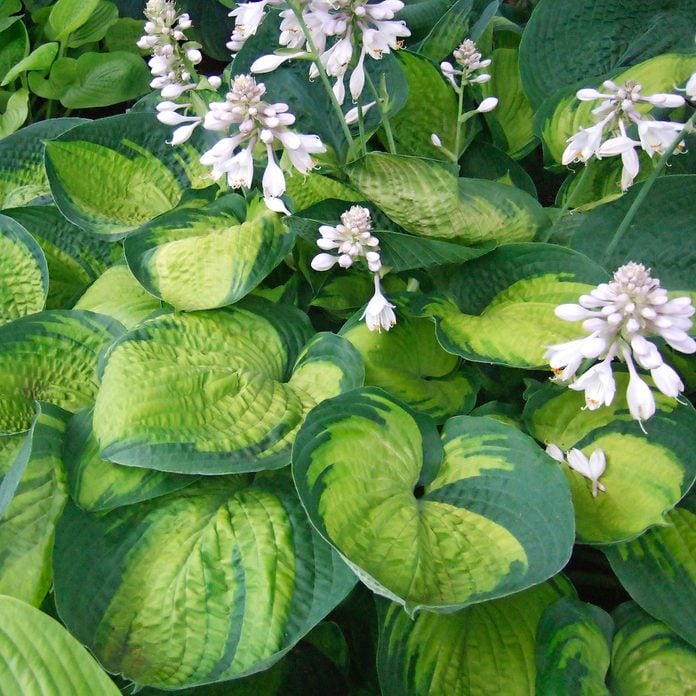
Hosta
Hosta species, Zones 3 to 9
Size: 6 to 30 inches
Although most hostas are grown for their leaves, they also have flowers that hummingbirds like. The large bell-shaped blooms are excellent nectar sources in hues of purple to white.
Why we love it: Everyone thinks of hummingbird plants for sunny areas, but the little fliers like a sweet treat in the shade, too.
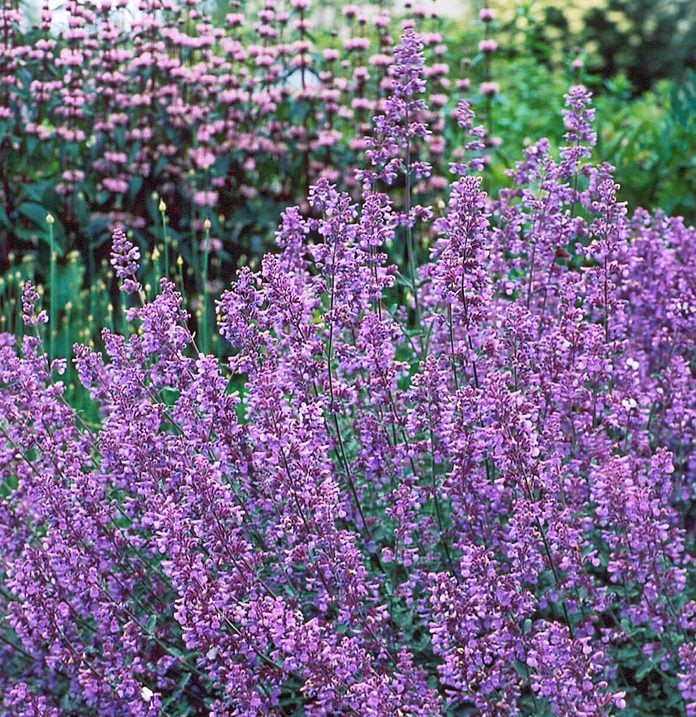
Catmint
Nepeta species, Zones 3 to 9
Size: 1 to 3 feet tall, often wider than it is tall
Catmint is easy to grow, long-blooming, heat-tolerant, and deer- and pest-resistant. After the hummingbird flowers fade, shear off the spent blooms and about a third of the stalk for a second round.
Why we love it: Hummingbirds especially like Siberian catmint’s blue blooms (Nepeta sibirica). Just be aware that this variety can be an aggressive grower.
Check out the top 10 purple flowers that attract hummingbirds.
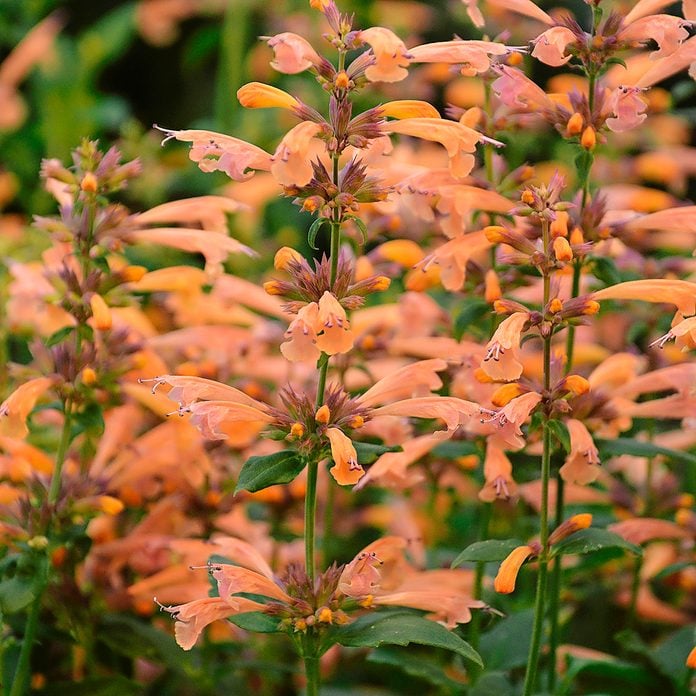
Agastache
Agastache species, Zones 4 to 9
Size: 1 to 5 feet tall
It’s no coincidence that a common name for one of the agastache species is hummingbird mint. That type excels in dry regions. Choose anise hyssop (Agastache foeniculum) in northern, wetter climates. Tiny tubular hummingbird flowers on slender stalks grow in a variety of colors and shapes. Full sun and excellent drainage are essential for keeping plants happy.
Why we love it: Deer and rabbits leave it alone.
Learn how to create an ideal hummingbird habitat.
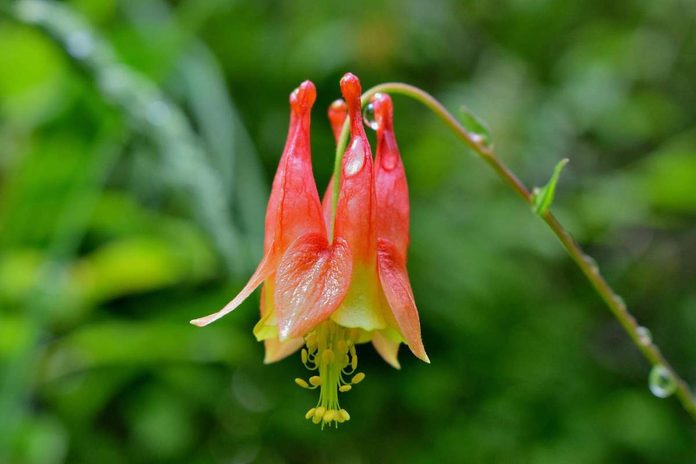
Eastern Red Columbine
Aquilegia canadensis, Zones 3 to 8
Size: 1 to 3 feet tall, 1 foot wide
This easy-to-grow perennial performs in part to full shade. It reseeds itself to replenish older plants, which tend to lose vigor after three or four years. The airy habit allows it to grow among other plants.
Why we love it: Sure, you can find cultivated varieties of columbine flowers, but native columbine, with its crimson spurs and bright yellow stamens, is an early-season favorite flower that hummingbirds like.
Psst—hummingbirds also love these pink nasturtium flowers.
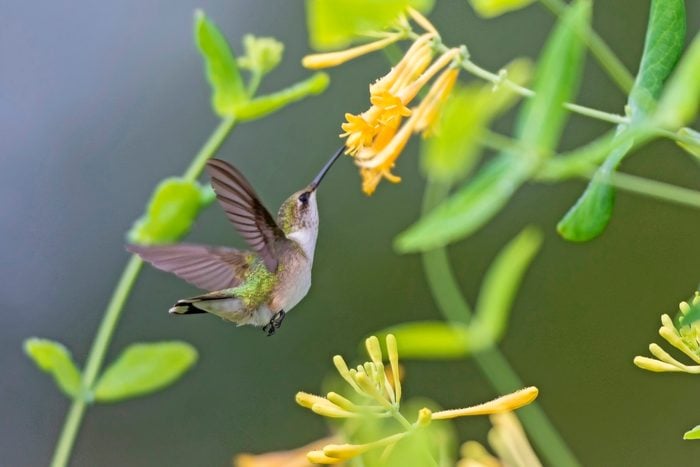
Trumpet Honeysuckle
Lonicera sempervirens, Zones 4 to 10
Size: 10- to 20-foot vine
If you have a fence, arbor or trellis in full sun to part shade, plant a colorful trumpet honeysuckle vine. Hummingbirds go absolutely wild for this climber. We don’t always recommend honeysuckle—many types are invasive—but this one is an exception worth considering. It’s native to many areas, and hummingbirds will visit all summer for its nectar. The vine climbs up to 12 feet tall and thrives in full sun to partial shade.
Why we love it: After a flush of blooms in late spring, flowers continue sporadically until fall. Prune or don’t prune—your choice.
“Trumpet honeysuckle is by far the most favored hummingbird plant in my yard. It blooms all season, produces fruit that other birds enjoy and is native to the United States,” says Karen Dennis, Plymouth, Michigan.
Psst—did you know that honeysuckle is the June birth flower?
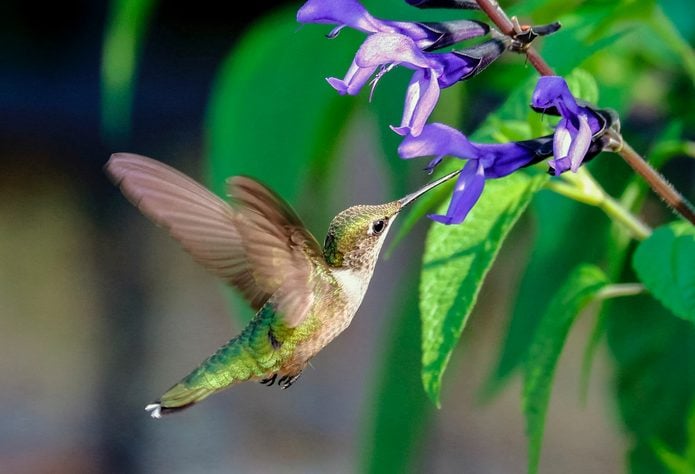
Salvia
Salvia species, annual to perennial Zones 3 to 10
Size: 1 to 6 feet tall
Pick a salvia, any type of salvia—hummingbirds like them all. The tubular blooms are just right for dipping a beak into. Salvias grow best in full sun to part shade. Annual salvia is a garden favorite, but don’t forget the power of the perennial variety. The blooms can reach 1 to 5 feet tall, flowering in bright shades of purple, indigo, maroon and even red. Grow in full sun, and you’ll probably want to add a few extra for the butterflies, too. Check out the top 10 salvias to grow for hummingbirds.
Why we love it: Almost continuously blooming, especially in hot, dry conditions, salvias come in a huge selection of colors and plant habits. Many gardeners grow these hummingbird flowers because they’re a good drought-tolerant option in summer. Don’t forget to grow it in well-draining soil for best results.
“I never had success with any flowers until I planted black & blue salvia,” says Alexa Wojtecki of Muscatine, Iowa.
Also grow Mexican bush sage and Playin’ the Blues Salvia for hummingbirds and butterflies.
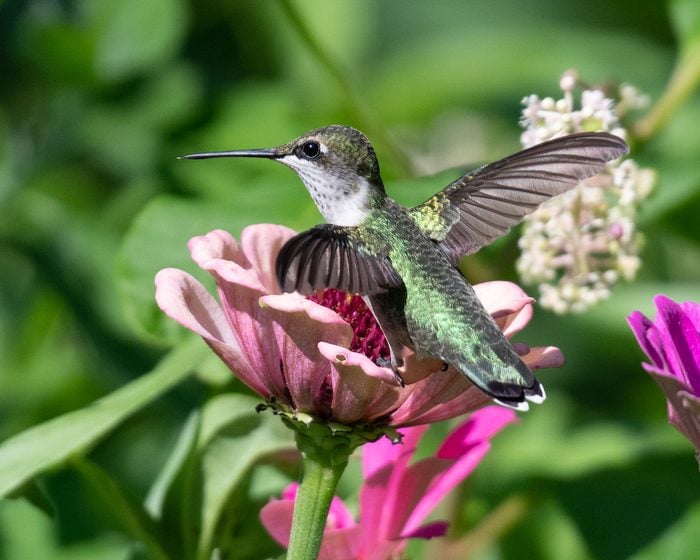
Zinnia
Zinnia elegans, annual
Size: 6 to 48 inches tall
Humans and hummingbirds like zinnia flowers for several reasons. They’re easy to grow from seed. The birds sip from the central florets, and you can snip the blooms to create indoor bouquets.
Why we love it: There are so many colors to choose from! If you’re planting a rainbow of colors and need green flowers, choose Queen Lime, Envy, Tequila Lime or other chartreuse varieties.
Learn how to attract hummingbirds to your balcony.
Flowering Tobacco
Nicotiana spp., annual
Often flying under the radar, this might be one of the best-kept secrets among hummingbird plants. Yes, it is an annual, but once gardeners discover the power of this flower, they eagerly plant it again and again. You can find it in a whole spectrum of colors, including pink, white, red, lavender and green.
Bonus tip: While it varies by cultivar, this plant is also known for its fragrance. If you like sweet-smelling blooms in the evening for a moon garden, make sure you pick a white-flowering variety.
Discover the types of hummingbirds found in the United States.
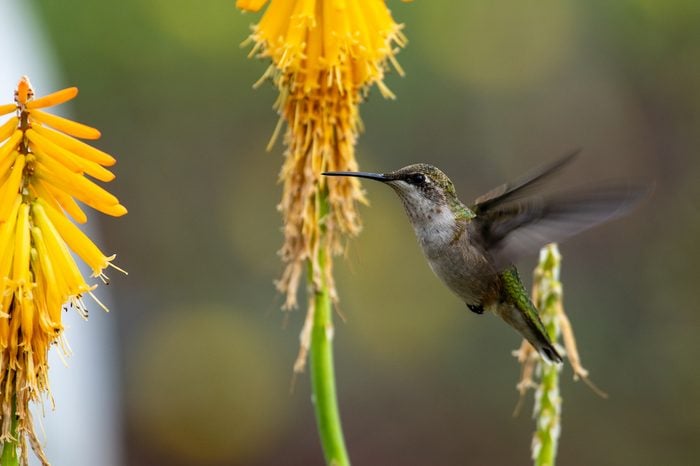
Red Hot Poker
Kniphofia, Zones 5 to 9
Red hot poker is one of the most dramatic and visually appealing flowers in the garden, pale yellow at the base and bold orange on top. Some varieties have an extra jolt of orange. The plants grow up to 4 feet high and are among the earlier summer bloomers.
Bonus tip: You really want to plant these in well-draining soil. They’re prone to rot in boggy or even moist soil.
Discover jaw-dropping facts about hummingbirds.
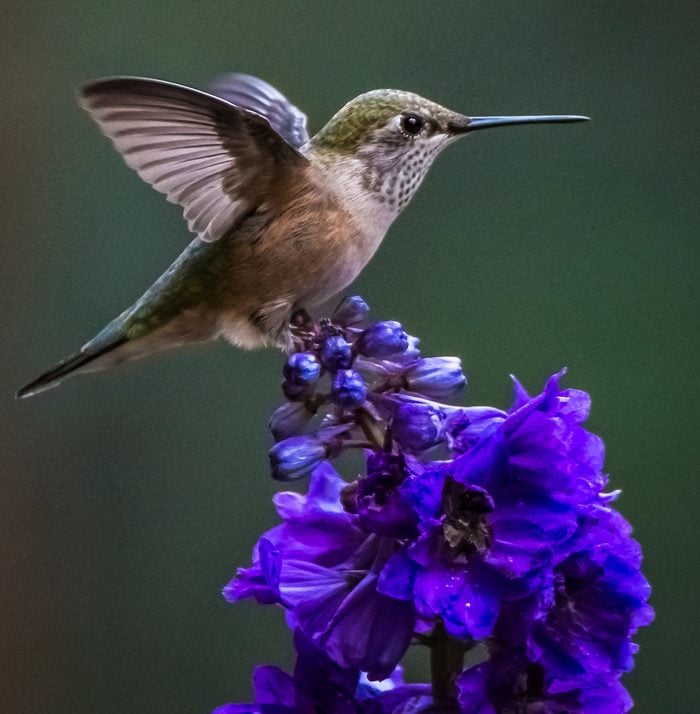
Delphinium
Delphinium, Zones 3 to 7
This towering treasure makes a statement at the back of a mixed border, as a vertical accent or in a container. With dozens of blooms on each stem, it gives hummingbirds plenty of nectar sources to share with butterflies and other bugs, too.
Bonus tip: Some delphinium varieties, like Summer Blues, are a lot bluer than others. For heat tolerance, try the Blue Mirror cultivar.
Get expert answers to your questions about hummingbird feeders.
Trumpet Vine
Campsis radicans, Zones 4 to 9
We see dozens of photos of hummingbirds at trumpet vine, and there’s a good reason. They like this sweet beauty! A perennial favorite of both butterflies and hummingbirds, it grows up to 40 feet tall.
Bonus tip: When you plant this stunner, it pays to invest in a good trellis, or put it next to a tree, telephone pole or sturdy fence. If you can provide this vine with good support, it will last for years.
Discover the top 10 vines for hummingbirds.
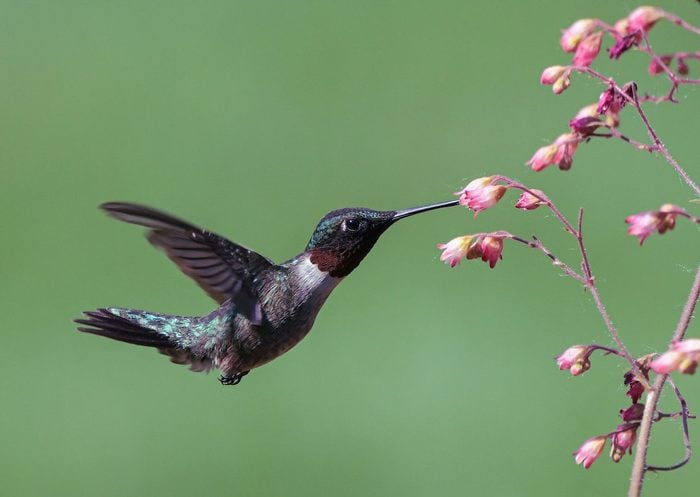
Coral Bells
Heuchera, Zones 3 to 9
Don’t overlook the power of pink, a color available in many species that we normally think of as having red flowers. Coral bells are valued for their foliage and shade tolerance. In late spring, the plant sends up attractive, long-lasting wands of tiny flowers that hummingbirds like all summer long.
Bonus tip: Spend time getting to know the different cultivars, which have some of the garden’s most diverse and beautiful foliage options. It won’t be long until you have your own favorites.
Readers’ Favorite Hummingbird Flowers
Firecracker Plant
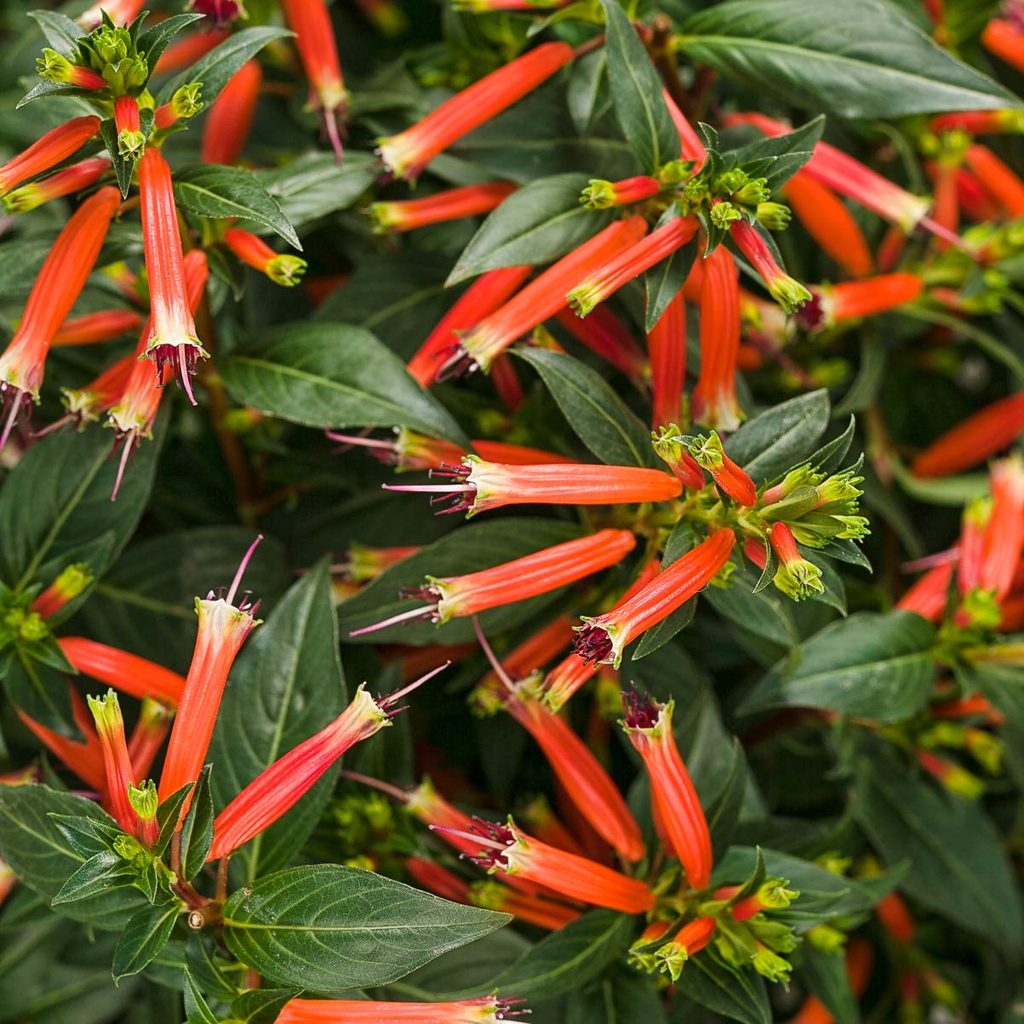
“Every year I place a big pot of large firecracker plant (Cuphea) on my deck. Hummingbirds are zipping about just inches from me all summer!” says Janet Doherty, Scarborough, Maine.
“I had two firecracker plants (Cuphea ignea) in pots next to my shed last summer. Every time I went outside, I saw two or three ruby-throated hummingbirds. They would even sit on the clothesline near the shed. They loved those flowers!” says Susan Michalewicz of Lockport, New York.
Red Canna Lily
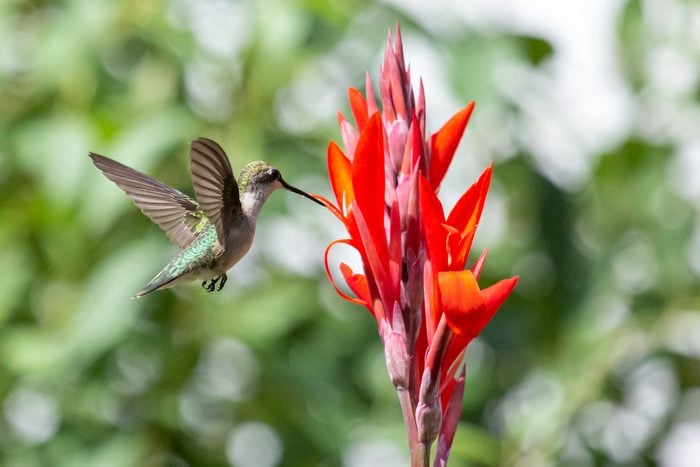
“Almost every time I look at my red canna lilies, there is a hummingbird at them,” says Liza Vaughn, Fairfax, Virginia.
Aloe Plant
“My aloe plant blooms four or five times each summer, sending up grand 4-foot stalks covered in bell-shaped flowers. Hummers sit on the branches and feed,” says Lorraine Smith, Lake Charles, Louisiana.
Autumn Sage
“My favorite is autumn sage. The abundant blooms are best in spring and fall. I also grow Turk’s cap and coral honeysuckle for hummingbirds,” says Kathy Eppers of Aledo, Texas.
Dark Eyes Fuchsia
“Our hummingbirds love the Hot Lips salvia and Dark Eyes fuchsia,” says Andrea Moore of Anacortes, Washington.
Lucifer Crocosmia
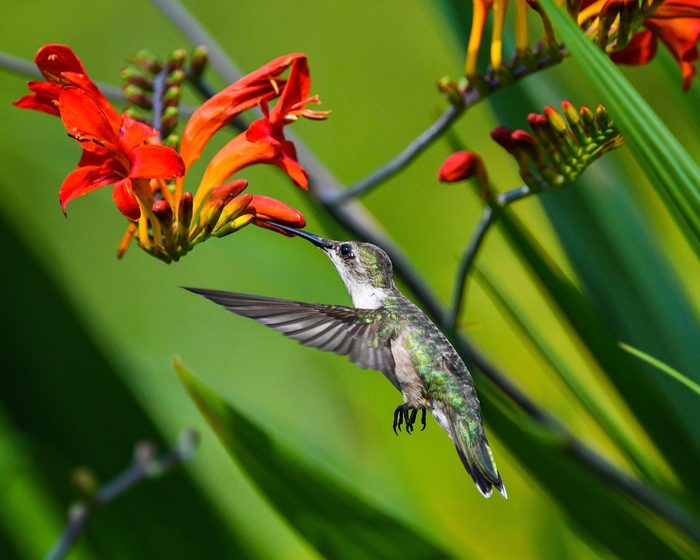
“Hummingbirds love my Lucifer crocosmia and enjoy it more than nectar from a feeder. I love watching them visit this perennial plant year after year!” says Jan Hardy of Pittsburgh, Pennsylvania.
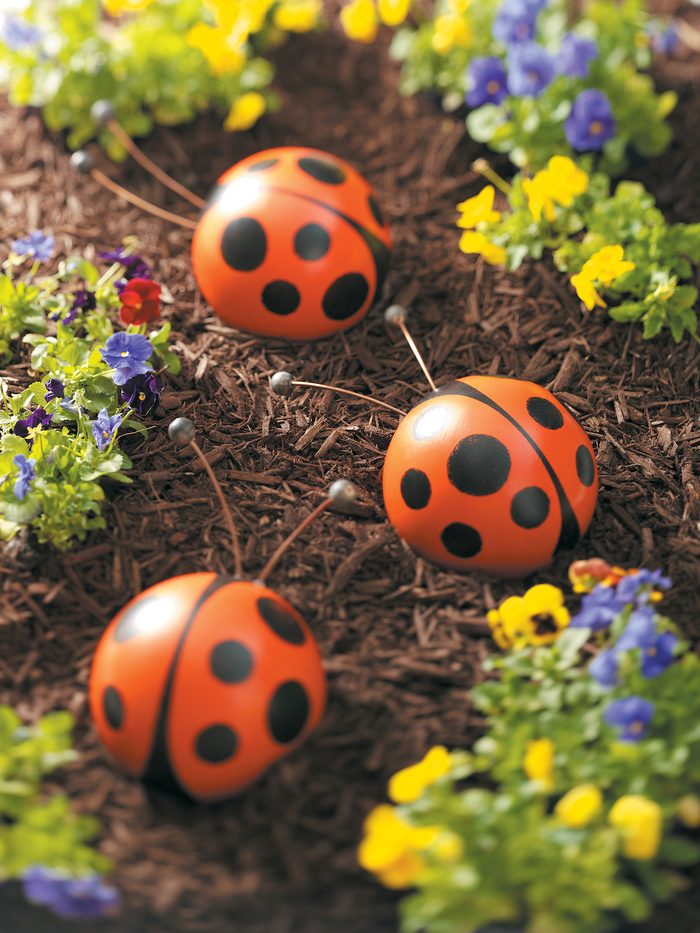
Retiring an old bowling ball? Create a striking ladybug for any garden—big or small. We got the idea for this bowling ball ladybug garden art craft project from reader Joyce Kline and had so much fun creating our own, we knew we had to share!
These garden pets are as easy as 1-2-3, so they’re a great project for kids to help with.
Editor’s note: A quart is the smallest can of mixed paint you can buy at the hardware store, but smaller quantities of acrylic hobby paint are available at craft stores. If you do have extra, use it to make a colony of bugs—or gifts for your envious neighbors! These cute critters also make perfect housewarming gifts and change-of-pace donations at charity raffles.
Here’s how to make DIY bowling pin butterfly garden art.
Materials:
- Bowling ball
- Black silicone caulk
- Two 8.5-inch lengths of #6 copper wire (have the hardware store cut it for you)
- Two 1-inch round wooden beads
- 1 quart Kilz exterior primer
- 1 quart red exterior latex paint
- 1 quart black exterior latex paint
- Painter’s tape
- Utility knife or scissors
- Stenciling brush or sponge
Step-By-Step Instructions:
Step 1
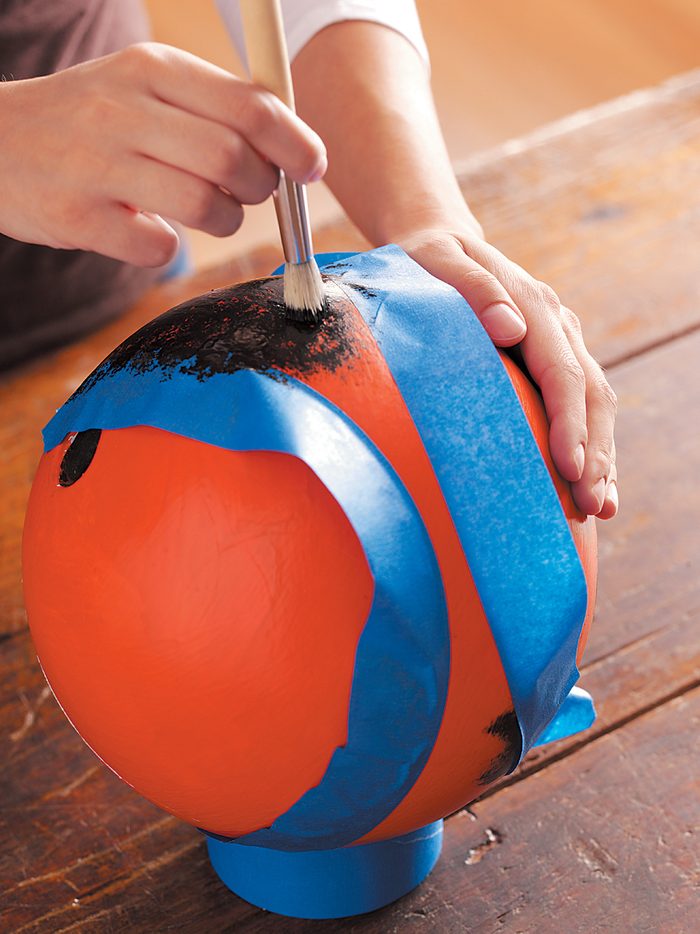
Prime and paint the bowling ball (three coats of red paint might be needed). After the paint is completely dry, apply painter’s tape in the desired pattern. Stipple on black paint with a stenciling brush or sponge for texture.
Step 2
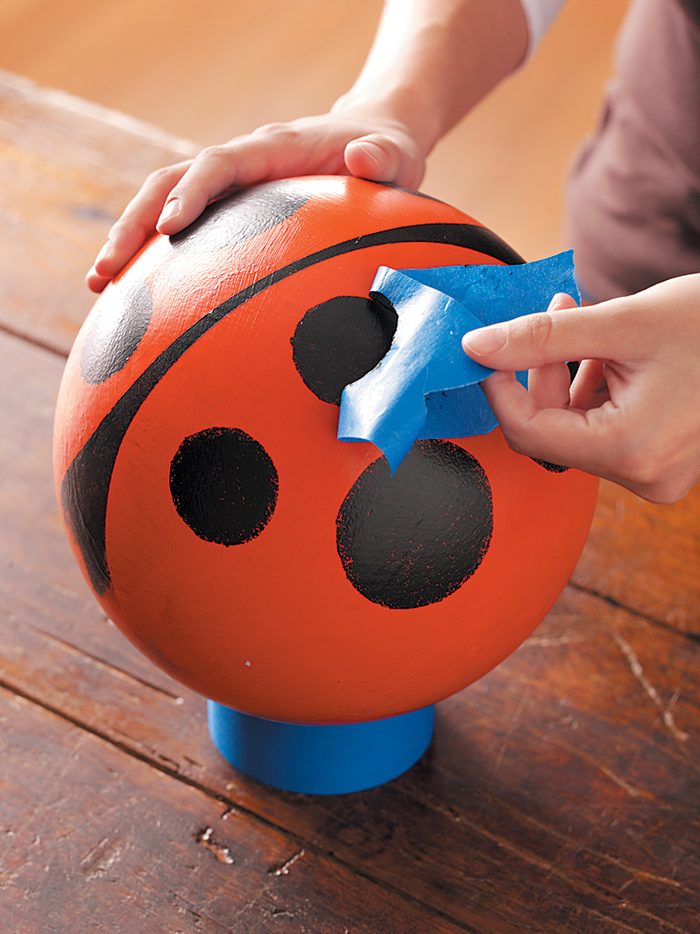
Make your own stencil by cutting differently sized circles from two pieces of painter’s tape put top to bottom. We used 2-1/2-inch- and 1-3/4-inch-diameter dots. Stipple the dots. After paint dries, remove the tape.
Step 3
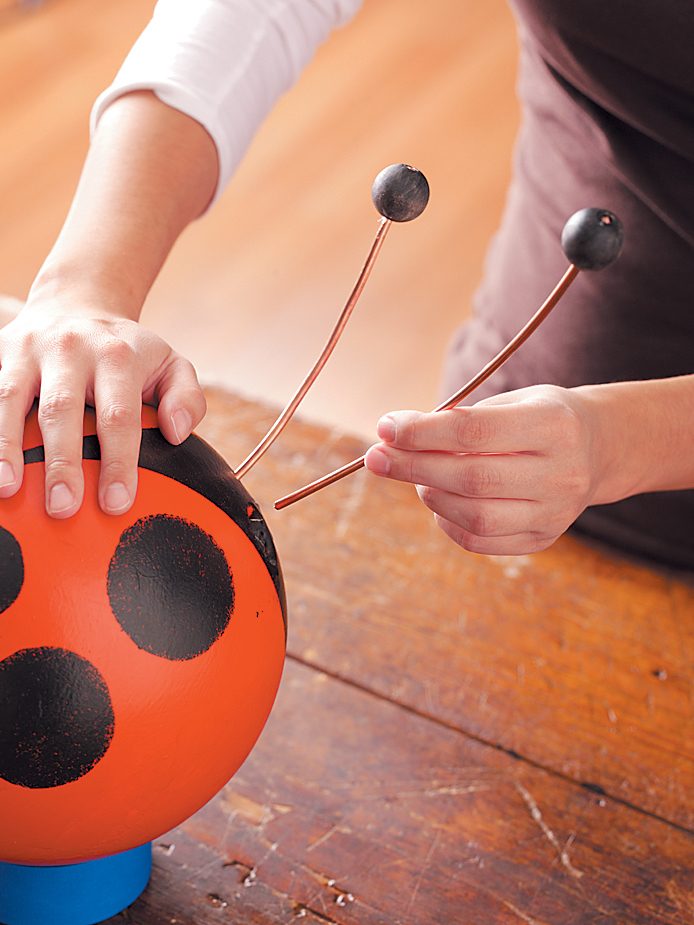
Fill the thumb hole with black caulk. Set in two antennae made from lengths of copper wire with painted wooden beads affixed to the top. You may need to prop them up so they don’t droop while drying for 24 hours.
Step 4
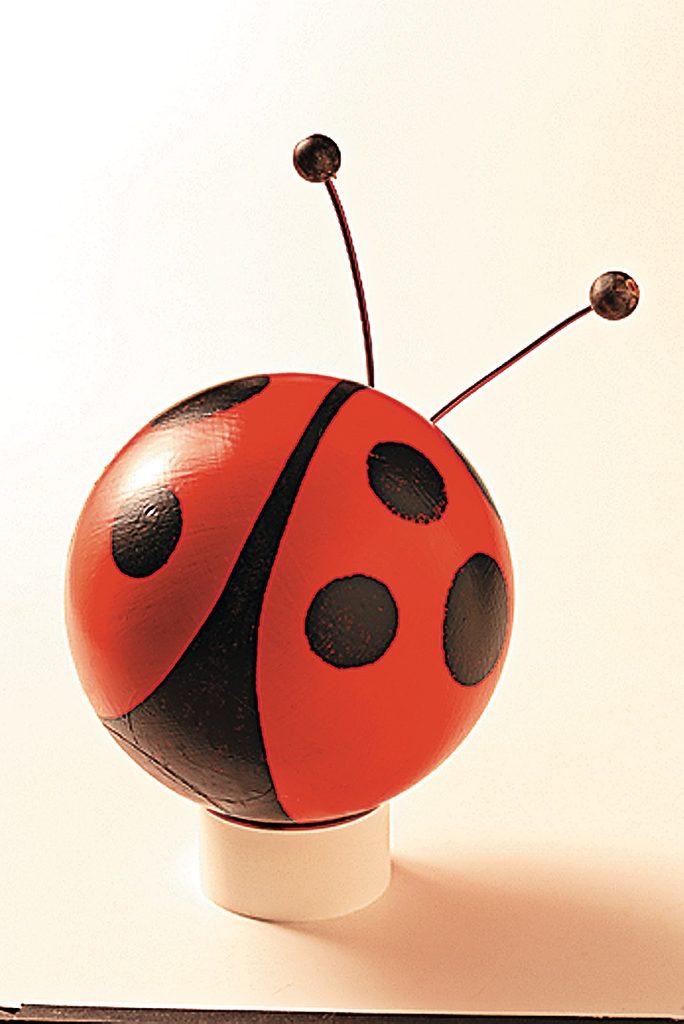
This bowling ball ladybug is so easy to create, you may want to make a whole flock!
Next learn how to make bumblebee bowling ball garden art.
